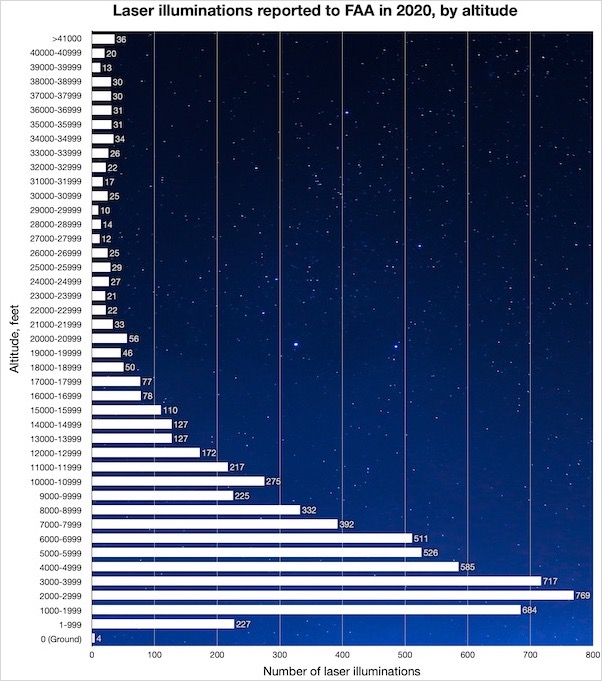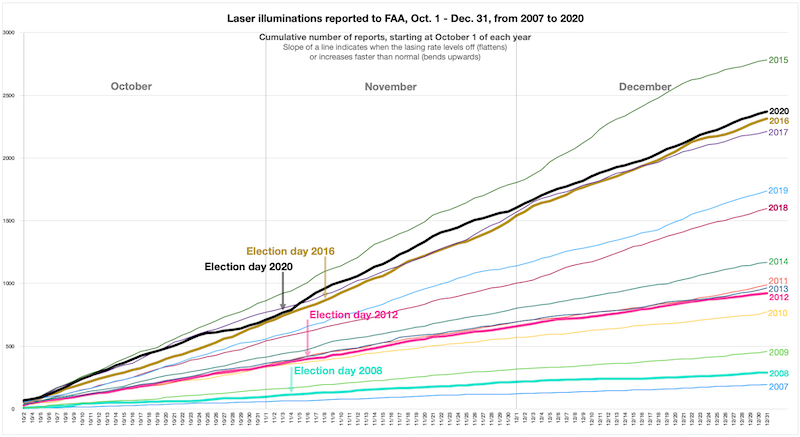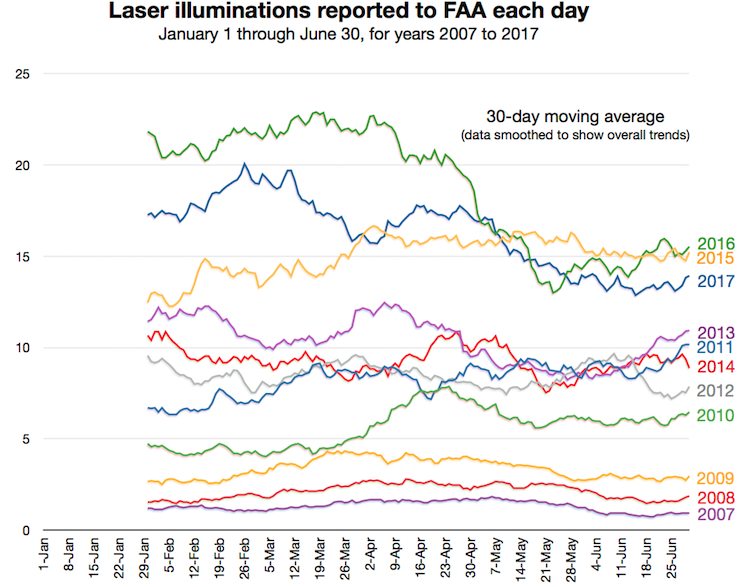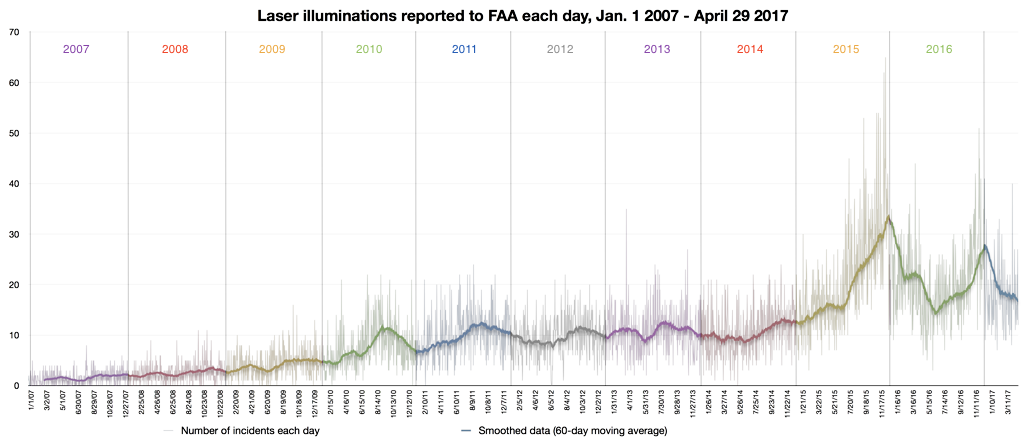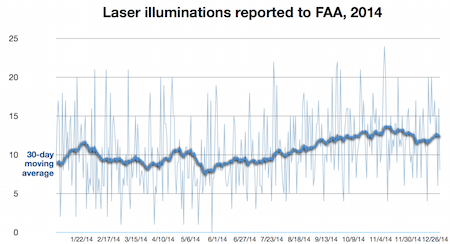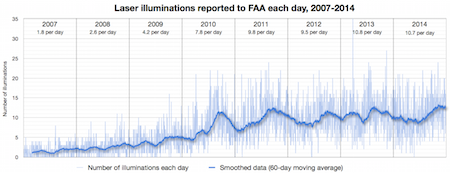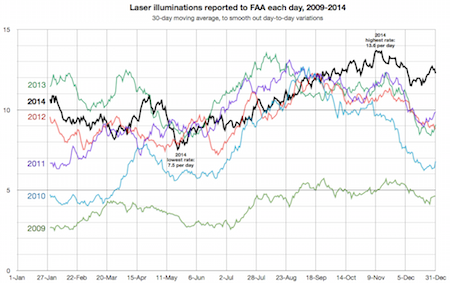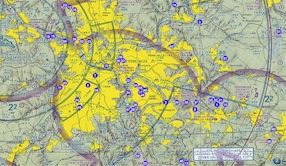Home
A comprehensive resource for safe and responsible laser use
US: GAO report says less than 1% of laser-aircraft incidents result in fines or prosecution
From July 2016 through September 2020, there were about 27,000 laser incidents reported by pilots to FAA.
Of these, 232 suspects were identified (0.86%). The "overwhelming majority… involved illumination of police and media aircraft", primarily helicopters that can hover over a scene. This hovering makes it much easier to identify perpetrators' locations, compared with fixed-wing aircraft that often cannot deviate from their route to chase after perpetrators.
FAA CIVIL ACTIONS
FAA took civil action against 99 of the 232 suspects:
• Assessed civil penalties against 70 of the 99 subjects. These civil penalties ranged from $50 to $27,338.29
• Proposed but had not assessed civil penalties against 17 of the 99 subjects.
• Ordered administrative actions (e.g. issuing warning notices to subjects) against three subjects
• Issued compliance actions (e.g. counseling) against eight subjects.
• Referred one case to the government of Canada for legal action because the subject was a Canadian resident.
This chart shows what happened to the remaining 133 suspects:
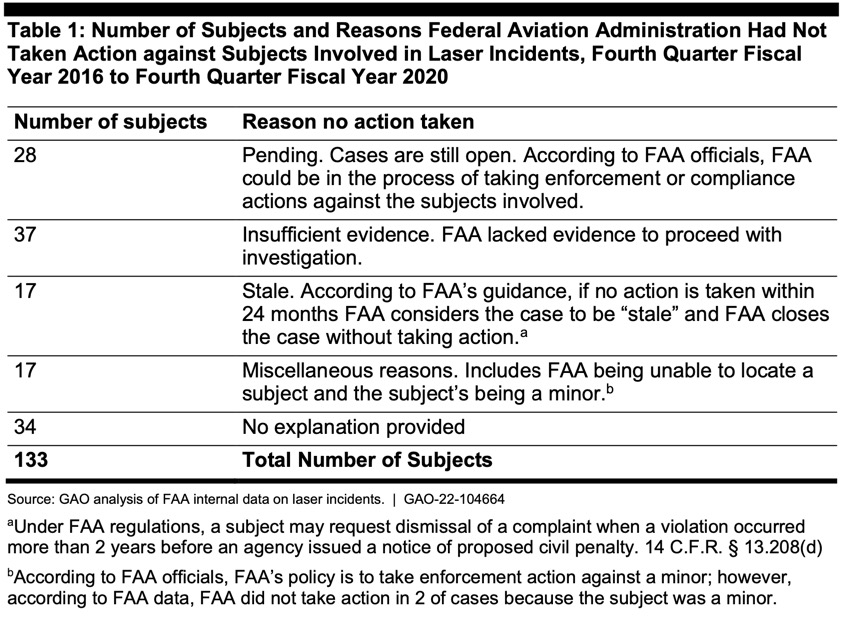
To summarize, out of 27,000 laser incidents there have been 70 persons fined so far (0.26%). There is the possibility of fining an additional 45 persons (17 proposed, 28 pending). If every one of these additional 45 persons was fined, that would make a total of 115 persons who would be fined (0.43%).
Thus, less than 1/2 of 1 percent of all laser incidents reported to FAA result in a fine or potential fine.
US ATTORNEYS' OFFICE CRIMINAL ACTIONS
In addition, there were criminal prosecutions. From the GAO report:
"According to our analysis, the FBI and other federal entities referred 86 laser incidents to USAOs for prosecution from July 2016 through September.32 Our analysis shows USAOs prosecuted 44 subjects, resulting in 40 convictions. In 23 of the 40 convictions, the subject received no term of imprisonment, while 15 subjects were sentenced to terms of imprisonment ranging from 3 months to 51 months."
"FBI officials told us federal prosecution may be more likely if a subject is suspected in a cluster of laser incidents, if a law enforcement aircraft was lased and a mission was interrupted, or if a subject had prior offenses, among other criteria."
Forty convictions out of 27,000 incidents is 0.15%. The 15 subjects imprisoned represent 0.06% of the incidents.
The report does not state if any of the criminal cases overlap with the FAA civil cases (e.g., a case is counted twice — once for FAA and once for criminal actions).
Data from the GAO's full 46-page report.
US: GAO report has three recommendations for FAA
The GAO began their study of the issue in November 2020. Their goal was to determine:
• "the extent to which [the U.S. Federal Aviation Administration] FAA and other federal agencies take enforcement action against those who point lasers at aircraft and challenges with investigations and reporting;"
• "public outreach efforts FAA and other federal agencies have taken to deter laser incidents, and what actions, if any, would strengthen these efforts; and"
• "options that stakeholders have identified to mitigate the effects of laser incidents, and the potential benefits and challenges to implementation."
FINDINGS
The following is from the "What GAO Found" summary of their findings:
"Aiming a laser at an aircraft can distract or disorient pilots and is a federal crime. The Federal Aviation Administration (FAA) investigates laser incidents, pursues civil penalties, and assists the Federal Bureau of Investigation (FBI) and U.S. Attorneys with investigations. Given the nature of laser incidents, FAA and federal law enforcement face difficulties identifying those involved. However, they have taken some enforcement actions, resulting in penalties ranging from $50 to $27,388 and sentences of up to 51 months, according to GAO analysis."
"To support incident investigations, FAA asks that pilots complete an incident questionnaire upon landing. However, FAA received responses for about 12 percent of the 8,221 laser incidents that occurred over a recent one-year period from 2020 to 2021. Reasons identified by FAA and others for the low response rate include the length of the questionnaire and its voluntary nature. Further, FAA does not consistently share collected information with law enforcement."
"In 2016, Congress required FAA to report quarterly on laser incidents, including data on civil and criminal actions. However, GAO found FAA’s reports to be incomplete. For example, GAO’s analysis shows 44 prosecutions from July 2016 through September 2020, when FAA reported only four. FAA officials said they do not routinely request data on the status of actions from other agencies and face challenges, such as access to this data. By not routinely seeking updates from agencies, FAA does not provide Congress with a complete picture of laser incident investigations and enforcement actions as required."
"FAA, FBI, and the Food and Drug Administration, which has regulatory authority over lasers, each conduct outreach to educate the public about laser incidents. These agencies were involved in an interagency group to address laser safety concerns until 2015 when the group dissolved. Since then, laser incidents have increased and identifying subjects remains difficult. FAA is well positioned to lead an interagency effort to explore re-establishing this group, given FAA’s responsibility for the safety of the national airspace."
RECOMMENDATIONS
The 46-page report recommended three actions to be taken by FAA:
1: "The FAA Administrator should determine what information from pilots and crewmembers would be most useful for investigating laser incidents, and how best to collect the information and to share it with law enforcement."
2: "The FAA Administrator should improve its quarterly reports to Congress on laser incidents by routinely seeking information from other agencies on related federal investigation and enforcement actions and disclosing, in those reports, any limitations with the data."
3: "The FAA Administrator should work with FBI and FDA to explore re-establishing an interagency working group on outreach to educate the public on the hazards of lasers and the illegality of aiming lasers at aircraft."
From the GAO webpage about the report. It includes a link to the full 46-page report.
COMMENTARY FROM LASERPOINTERSAFETY.COM
While the three recommendations are useful, we are disappointed that the GAO report did not make a primary recommendation that FAA should require pilot training on how to handle laser illuminations. In our view, this is the single most important safety step that FAA could take.
The report does discuss this, beginning on page 30 with this paragraph:
"Most stakeholders told us that training pilots on how to respond to laser incidents is an important mitigation strategy. For example, representatives from an organization representing law enforcement pilots told us that training pilots in responding to laser incidents is important because there will always be laser incidents. These representatives said that even with effective public outreach and enforcement activities, there would be people intentionally trying to harm aircraft and that in these situations, it is important for pilots to know how to react. Additionally, representatives from a group representing pilots told us they recommend airlines develop and incorporate a laser strike training module at a minimum of every 2 years." (emphasis added)
However, the GAO report simply lists some pilot training efforts. It does not say that FAA should mandate this.
LaserPointerSafety.com has also recommended that pilots be exposed to safe, simulated laser light during simulator training. This gives a flavor of what a bright light disruption can be and helps "inoculate" pilots so they know what to do, just as they train for other aviation emergencies.
US: 9,723 illuminations reported to FAA during 2021
This means pilots saw lasers on average 26.6 times each day in 2021.
The chart above, and other detailed statistics, are on the Laser/aircraft illuminations statistics page. This includes data such as the following:
- The total number of U.S. laser/aircraft incidents since reporting to the FAA was mandated in 2004, is 71,435 as of Dec. 31, 2021.
- The total number of worldwide laser/aircraft incidents reported to authorities since 2004 is 102,104. Only eight countries are included in this cumulative total, and many of these do not have data for some years in the 2004-2021 time period, so the actual number of incidents is higher.
- Green laser light remains the most-reported. In 2021, 86.1% of incidents involved green light; blue was second with 8.8%. The number of blue lasers reported has, in general, increased over the past few years. For example, in 2016 only 2.9% of incidents involved blue laser light.
- In 2021, 0.5% of FAA-reported laser/aircraft incidents indicated that crew members suffered eye effects or temporary injuries. This rate has decreased since 2011, when 1.4% of incidents incurred eye effects or temporary injuries. The most-reported effects were flashblindness and/or afterimage; pain, burning or irritation; blurriness; and unspecified eye injuries.
US: FAA details fines since 2016 for laser strikes
Dickson noted that "if a person shines a laser at a plane, it can mean a fine of up to $11,000 for a single incident and up to $30,800 for multiple incidents."
He added, "Like many crimes, there is a need for education, outreach, and the cooperation from the public to address this safety risk. We encourage the public to report laser strikes to the FAA via our website or to your local law enforcement agency."
From the FAA video on YouTube
US: FAA webpage analyzes laser strike statistics
It includes graphs of yearly, monthly and daily laser event numbers, data on events by month and by day of the week, states ranked by raw numbers and on a per capita basis, injuries, and altitudes at which lasers were seen. By clicking on data points or sections of a chart, a box pops up with more precise information.
Here is the top part of the webpage as it appeared in September 2021:
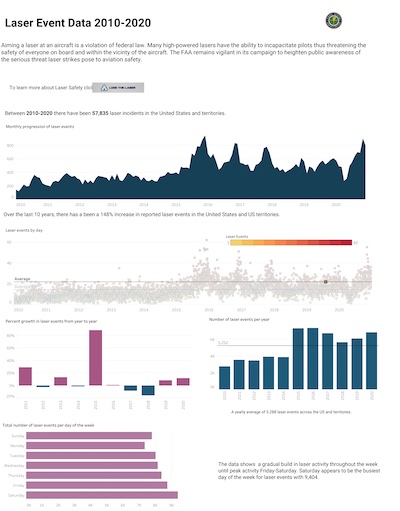
From FAA's data visualization webpage. If this link does not work, the data might also be accessed from FAA's main laser safety webpage. T
COMMENTARY FROM LASERPOINTERSAFETY.COM
Many of the FAA charts on the webpage are very interesting, such as the number of laser events per capita for each state. For example, Hawaii leads the country in laser illuminations per capita, in 2020.
However, some charts are near useless such as the "injuries" chart. This is organized by state, not by type of injury. Worse, there is no information provided about what counts as an injury, or the severity and outcome of the reported injury. (We have our own injury analysis chart on this page which is much more detailed.)
Another near-useless FAA chart is one that shows aircraft altitude during the incident. The chart shows data points with the number of flights at a given altitude. But there is no attempt to group altitude ranges together, for example, to find out how many laser incidents happened between 0-1000 ft, between 1000-2000 ft, etc. 
In contrast, this chart (done by LaserPointerSafety.com) has the same data formatted in a more understandable way:
US: Air Force develops laser glare protection glasses for pilots
Washington State Patrol pilots successfully test special laser eye protection developed at Wright-Patterson Lab
Story by Mary Pacinda, Air Force Research Laboratory
Aiming a laser at an aircraft is a federal crime that can net offenders up to five years in jail or cost them a $250,000 fine. Even with this heavy potential penalty, laser strikes have become increasingly more common. According to the FAA, 6,852 such incidents were reported in 2020, compared with 385 in 2006, and so far this year, incidents of “joy lasing” are up 20 percent over last year. Cheap and easily obtained, hand-held lasers used as pointers and cat toys are certainly harmless when used as intended. But when they are aimed at the cockpit of an aircraft, they can temporarily blind the pilot — with possibly deadly consequences.
Laser strikes are almost always made at low altitudes when an aircraft is taking off or preparing to land — the two parts of flying that require the most attention from a pilot. Even if the beam of light does not hit the pilot’s eyes directly, it can cause a distraction or even raise an alarm that the plane may have become a target. In addition to the possible adverse effects of these human reactions, slight imperfections in the plane’s windscreen can cause the laser light to spread out, creating a glare that can temporarily obscure all vision inside the cockpit.
Of course, passing a law against any behavior — including pointing a laser at an airplane — seldom puts an end to the behavior. Thus, the best way to avoid disaster from laser strikes is to provide some sort of protection for the pilot. As a result, in recent years several manufacturers have developed laser eye protection (LEP) to meet a growing demand for help from military and law enforcement pilots. But this solution is not without problems of its own.
Most laser eye protection works by filtering out green or red light, the colors most commonly used in handheld lasers. Unfortunately, according to FAA studies and years of pilot experience, this can change the pilot’s ability to accurately read the instrument control panel. A 2019 FAA report suggested that this problem might be fixed by changing the type of lighting in the control panel.
Researchers at the Air Force Research Laboratory recently came up with a better solution, one that was successfully tested on the job by Washington State Patrol pilots.
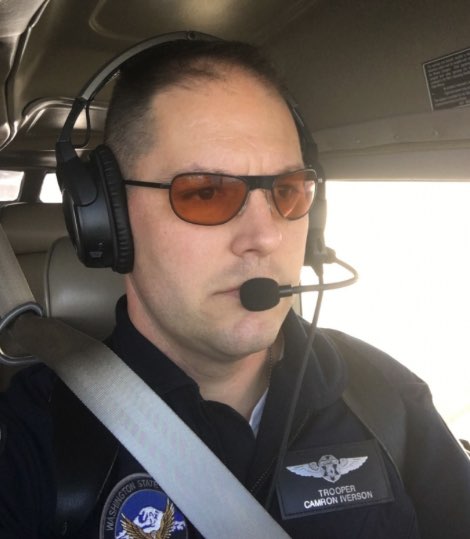
Flight Officer Camron Iverson of the Washington State Patrol tested laser protection lenses formulated at AFRL’s Materials and Manufacturing Directorate. (Photo by Mary Pacinda)
The Personnel Protection Team in AFRL’s Materials and Manufacturing Directorate, headed by Dr. Matthew Lange, used the cockpit compatibility design software developed for Department of Defense LEP and modified it for commercial use. The commercial version, called CALI (Commercial Aviation Low Intensity) filters out the laser light, but not the light coming from the pilot’s instrument panel. “Simply put,” said Lange, “the lenses maximize protection while minimizing the impact to the cockpit.”
US: Why did lasers aimed at aircraft increase after the 2020 election?
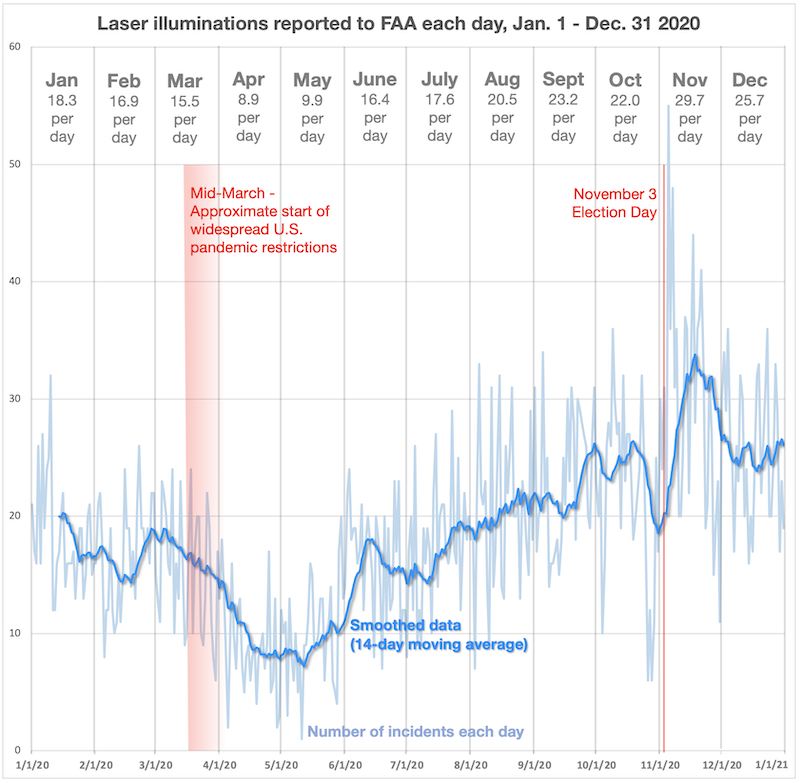
In fact, of the 10 highest days (most incidents) in 2020, all but one occurred in the Nov. 5-21 period. There were 55 incidents on Nov. 5, 48 on Nov. 6, 44 on Nov. 17, and 41 on Nov. 21. These occurred more than twice as often, compared with the 2020 average of 18.7 incidents per day.
Is this a statistical anomaly or did the disputed election results somehow lead to an increase in laser incidents?
COMMENTARY AND ANALYSIS BY LASERPOINTERSAFETY.COM
The chart below indicates that the three previous U.S. presidential elections did not have an effect on lasing incident rates.
It shows that in 2008, 2012, and 2016 the number of laser incidents each day between October 1 and Dec. 31 rose smoothly and steadily. In contrast, the lasing rate in 2020 (black line) slowed substantially around October 26, and rose significantly just after Election Day on November 3.
However, these two effects appear to counter each other. It may be that some other factor, such as how FAA records or processes laser incident reports, slowed in late October and sped back up in November.
In summary, while it is tempting to say that agitation over the 2020 election results led to an increase in persons aiming lasers at aircraft, this was not seen in previous election years and may be a statistical anomaly.
US: 6,852 laser illuminations reported to FAA in 2020
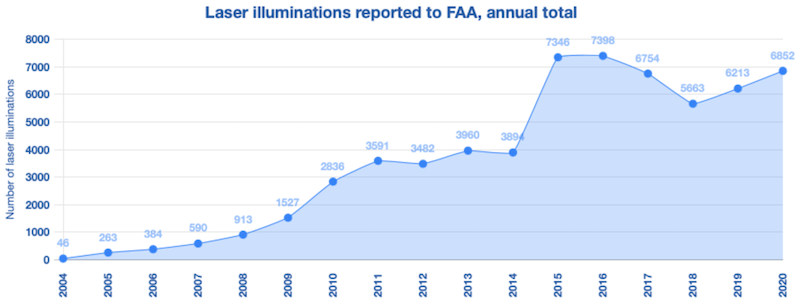
This means pilots saw lasers on average 18.7 times each day in 2020. However, the lasing rate was not evenly distributed. It reached a monthly low of about 9 illuminations per day in April 2020 — just as nationwide pandemic restrictions started. The highest rate was in November 2020, with almost 30 illuminations per day.

The peak number of illuminations, 55 on Nov. 5, occurred two days after the contentious 2020 election, when a presidential winner had not yet been declared. Of the 10 highest days (most incidents) in 2020, all but one occurred in the Nov. 5-21 period. A separate story at LaserPointerSafety.com discusses whether this is a coincidence or if there is some correlation with the election.
The charts above, and other detailed statistics, are on the Laser/aircraft illuminations statistics page. This includes data such as the following:
- The total number of U.S. laser/aircraft incidents since reporting to the FAA was mandated in 2004, is 61,712 as of Dec. 31, 2020.
- The total number of worldwide laser/aircraft incidents since 2004 is over 90,000. Only eight countries are included in this cumulative total, and many of these do not have data for some years in the 2004-2020 time period.
- Green laser light remains the most-reported. In 2020, 85.4% of incidents involved green light; blue was second with 9.2%. The number of blue lasers reported has steadily increased over the past few years. For example, in 2016 only 2.9% of incidents involved blue laser light.
- In 2020, only 0.3% of FAA-reported laser/aircraft incidents indicated that crew members suffered eye effects or temporary injuries. This rate has decreased since 2011, when 1.4% of incidents incurred eye effects or temporary injuries. The most-reported effects were flashblindness and/or afterimage; pain, burning or irritation; and blurriness.
US: 2019 laser incidents up almost 10% compared to 2018
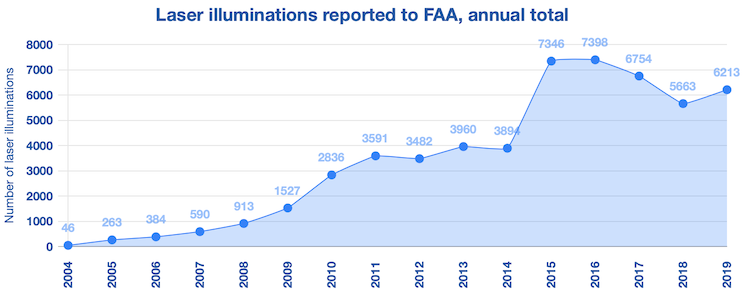
During 2019 there were 17 laser incidents reported each night in the U.S., on average.
This brings the 15-year total to 54,860 incidents since 2004 when FAA first started requiring pilots to report laser sightings or illuminations.
The majority of reports continue to involve green lasers (87.2% of 2019 reports). However, reports of blue lasers have risen steadily, from 2.9% in 2016 to 8.2% in 2019.
Holiday lights do not seem to be a significant problem. In 2019 there were only 11 reports (out of 6,213) involving Christmas or holiday laser light projections.
The number of incidents with reported eye effects or claimed injuries was 31 in 2019, a significant increase over the 23 reported in 2018. There were no serious or permanent injuries. The most-reported effect was being flashblinded and/or seeing spots. Six pilots had pain, burning or irritation in their eye. Only three pilots sought or considered seeking medical attention for their eye effects — the lowest number in the seven years analyzed by LaserPointerSafety.com (2011, 2012, and 2015-2019).
FOR MORE INFORMATION: Additional charts showing U.S. and other country laser illuminations, are on the Laser/aircraft illumination statistics page.
US: FAA warns against aiming holiday lasers into the sky
With the holiday season upon us, the Federal Aviation Administration (FAA) wants to make sure your laser-light displays are aimed at your house and not into the sky.
Each year we receive reports from pilots who are distracted or temporarily blinded by residential laser-light displays. You might not realize this, but a well-meaning attempt to spread holiday cheer has the potential to create a serious safety risk to pilots and their passengers flying overhead.
So please make sure all laser lights are directed at your house and not into the sky. The extremely concentrated beams of laser lights reach much farther than you might realize.
If we become aware that your laser-light display affects pilots, we’ll ask you to adjust them or turn them off. If your laser-light display continues to affect pilots, despite our warnings, you could face a civil penalty.
Laser strikes against aircraft continue to increase each year. Last year we received 6,754 reports of laser strikes against aircraft, a 250 percent increase since we started tracking laser strikes in 2010.
Intentionally aiming a laser at an aircraft is a serious safety risk and violates federal law. Many high-powered lasers can completely incapacitate pilots who are trying to fly safely to their destinations and may be carrying hundreds of passengers.
We work with federal, state, and local law enforcement agencies to pursue civil and criminal penalties against individuals who purposely aim a laser at an aircraft. We may impose civil penalties of up to $11,000 per violation. Civil penalties of up to $30,800 have been imposed by the FAA against individuals for multiple laser incidents.
US: FAA data shows lower numbers for 2015 and other years
The original, higher figure came from the December 31 2015 FAA Laser Report. This spreadsheet of laser incidents had 7,703 rows with each row listing one laser illumination report.
In January 2016, researcher Dr. Todd Curtis cleaned up the list and found 7,676 valid reports. (The clean-up criteria is not known.)
The FAA's new, lower number of 7,346 reports was first noticed by LaserPointerSafety.com in an April 10 2019 fact sheet released by FAA. The agency has a separate page with Microsoft Excel spreadsheets listing reported laser incidents for 2010 through 2018. The spreadsheet now online for 2015 has only 7,346 reports — not the 7,703 reports of the original December 31 2015 FAA spreadsheet.
LaserPointerSafety.com has analyzed some of the dropped reports. A few may be duplicates, but many appear to be valid reports dropped for an unknown reason.
LaserPointerSafety.com believes that the original 7,703 figure is closer to the actual number of laser illumination reports submitted by pilots in 2015. However, for consistency, as of May 5 2019, LaserPointerSafety.com is using the new April 2019 FAA numbers on various pages such as the Laser/aircraft illumination statistics page.
Note that there may be some website pages and some articles, scientific papers, etc. outside of the website which reference the original, pre-April 2019 numbers.
Changed numbers also for 2007, 2008, 2016 and 2017
The number of laser incidents reported in other years has also changed:
- 2007 was originally listed as having 639 reports; in April 2019 FAA said there were 590 reports.
- 2008 was originally listed as having 949 reports; in April 2019 FAA said there were 913 reports.
- 2016 was originally listed as having 7,442 reports; in April 2019 FAA said there were 7,398 reports.
- 2017 was originally listed as having 6,753 reports; in April 2019 FAA said there were 6,754 reports.
US: FAA credits "heightened public awareness" for lowering laser incident numbers in 2017 and 2018
Incidents reported to FAA have declined from 7,398 reports in 2016, to 6,754 reports in 2017, and 5,663 reports in 2018, the last full year for which statistics are available.
According to FAA, "the agency and law enforcement agencies are working hard to increase public awareness of the dangers posed by lasers."
The news item linked to a page entitled "Laser Incidents and Legal Interpretation of the Law", a new video published April 10 2019 on YouTube, entitled "Laser Strikes on Aircraft Pilots", and an April 10 2019 Fact Sheet on lasers.
One paragraph of the fact sheet says that "The FAA’s guidance for agency investigators and attorneys stresses that laser violations should not be addressed through warning notices or counseling. The agency seeks moderately high civil penalties for inadvertent violations, but maximum penalties for deliberate violations. Violators who are pilots or mechanics face revocation of their FAA certificate, as well as civil penalties."
From FAA news item "Outreach Helps Bring Laser Strike Numbers Down"
COMMENTARY FROM LASERPOINTERSAFETY.COM:
We are not aware of any recent (2015-2018) campaign by FAA to increase public awareness.
In 2014, there was a publicity campaign by the Federal Bureau of Investigation (FBI) in 12 U.S. cities between February 11 and April 11 2014, which offered a $10,000 reward for information about anyone pointing a laser at an aircraft. This was expanded nationwide between June 3 and September 1 2014. During 2014 there was a 12.8% decline in laser incidents compared to 2013. It is not known how much the FBI publicity campaign contributed to the decline.
In our view, there may be other reasons for the decline. For example, pilots may be tiring of reporting laser illuminations with no apparent follow-up or effect. This would lead to a decline in reported incidents.
We are not aware of any studies done to determine the reasons for declines in reported laser incidents.
To summarize, it seems incorrect to attribute the lower number of laser incidents to "heightened public awareness." In fact, there is some anecdotal evidence that publicity actually leads to copycat laser incidents.
US: UPDATED - 6,753 laser/aircraft incidents reported to FAA in 2017; 9% lower than 2016
During 2017, there were 6,753 laser illumination incidents reported to the U.S. Federal Aviation Administration. This compares with 7,442 reports in 2016, and 7,703 reports in 2015. This is a 9% drop compared with 2016, and a 12% drop compared with 2015.
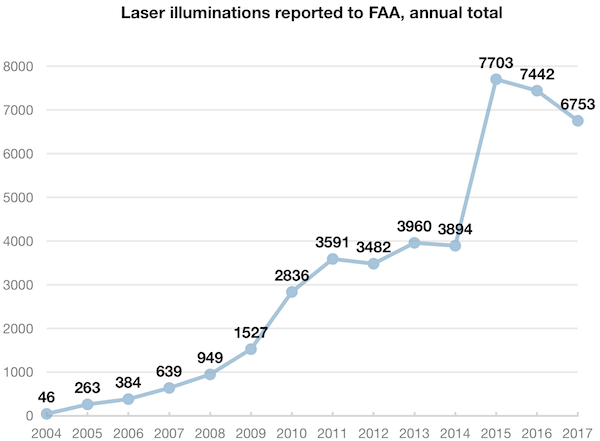
Here is the same data, plotted to show the average number of illuminations per day, during each year:
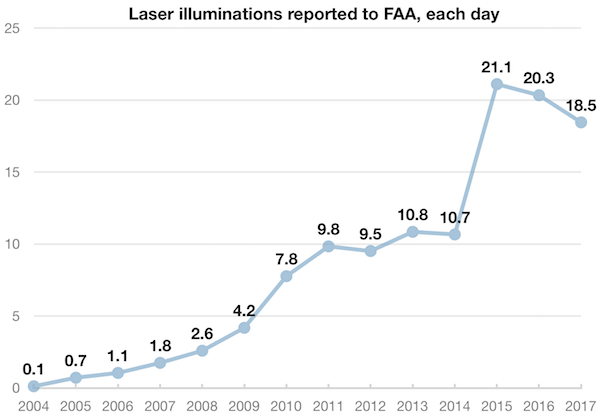
For additional charts and statistics, click the “read more” link.
US: FAA issues warning about holiday laser lights
Enjoy Your Holiday Laser-light Display Responsibly
Each holiday season for the past several years, the Federal Aviation Administration (FAA) has received reports from pilots who said they were distracted or temporarily blinded by residential laser-light displays.
The FAA's concerns about lasers – regardless of the source – is that they not be aimed at aircraft in a way that can threaten the safety of a flight by distracting or blinding the pilots. People may not realize that systems they set up to spread holiday cheer can also pose a potential hazard to pilots flying overhead.
So if you’re going to install a holiday laser-light system, please make sure the lights are hitting your house and not shining up into the sky. It may not look like the lights go much farther than your house, but the extremely concentrated beams of laser lights actually reach much further than most people think.
If the FAA becomes aware of a situation where a laser-light display affects pilots, we start by asking the owner to adjust them or turn them off. However, if someone's laser-light display repeatedly affects pilots despite previous warnings, that person could face an FAA civil penalty.
Note: The FAA press release was reprinted in a number of news sources including KUSA, the News Tribune and SFGate.
LaserPointerSafety.com has a separate story about the number of FAA laser incident reports in 2017 due to actual or suspected holiday light displays.
US: FAA requests comments by Oct 31 2017 regarding form used to report outdoor laser operations
The form is filled out by commercial and professional users who want to operate lasers outdoors, including laser light shows, observatories, LIDAR operators, and satellite communications.
According to FAA, there have been about 400 laser operators who filled out the form. The agency also says it takes 4 hours to gather information needed for the form and to fill it out.
FAA needs to periodically review whether the form is useful and whether the 4-hour estimate is accurate. The deadline for comments is October 30 2017.
The August 31 2017 Federal Register notice states:
“In accordance with the Paperwork Reduction Act of 1995, FAA invites public comments about our intention to request the Office of Management and Budget (OMB) approval to reinstate a previously approved information collection. In order for the FAA to ensure safety it proposes to collect information from potential outdoor laser operators. The FAA will review the proposed laser activity against air traffic operations and verify that the laser operation will not interfere with air traffic operations.”
The notice details what information specifically is requested:
“You are asked to comment on any aspect of this information collection, including (a) Whether the proposed collection of information is necessary for FAA's performance; (b) the accuracy of the estimated burden; (c) ways for FAA to enhance the quality, utility and clarity of the information collection; and (d) ways that the burden could be minimized without reducing the quality of the collected information. The agency will summarize and/or include your comments in the request for OMB's clearance of this information collection.”
Form AC 7140-1 does not impact laser pointer users per se, but it can affect professional outdoor laser users.
- The most impacted are outdoor laser light show operators. They are required by the Food and Drug Administration to submit their shows to FAA, and to receive a “letter of non-objection” from FAA, before FDA will grant permission (a “variance”) for a show.
- All other outdoor users are requested to submit Form AC 7140-1, but are not legally required to do so. This is because FAA has no regulatory authority to restrict outdoor laser usage. There may be organizations such as NASA or observatories that have internal requirements to submit AC 7140-1 and receive a letter of non-objection. This is usually done in the spirit of cooperation and/or to help avoid liability issues in case of problems.
Additional information, including instructions on how to submit comments, is at the Federal Register notice webpage. LaserPointerSafety.com has a webpage with suggested corrections to Advisory Circular 70-1, and advice on filling it out.
US: UPDATED - 2017 laser incidents on pace to be lower than 2016
As of June 30 2017, there were 2,933 laser illuminations of aircraft reported to the U.S. Federal Aviation Administration. This is 15% fewer than the 3,441 illuminations reported as of June 30 last year (2016).
The chart below shows cumulative laser illuminations for the period Jan. 1 - June 30, for each of the past 10 years. The blue 2017 line shows that thus far there have been fewer incidents in 2017 than in 2016, but more than in 2015.
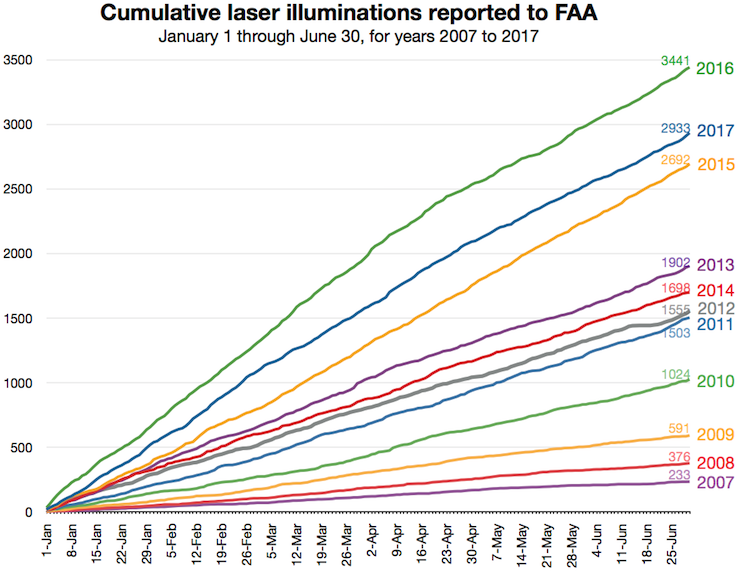
How to read this chart: Each year starts with 0 illumination reports. Each colored line then plots the cumulative (year-to-date) illumination reports for that year since January 1. For example, looking at the 2016 top green line, there were about 1000 reports between Jan. 1 and Feb. 12 (where the green 2016 line crosses the 1000 horizontal line). In contrast, in 2013 (purple line) there were roughly 500 reports between Jan. 1 and Feb. 12 (where the purple 2013 line crosses the 500 horizontal line).
Based on historical data, LaserPointerSafety.com projects that there will be around 7,200 laser illuminations reported to the FAA in 2017. This would be about 4% lower than the 7,442 reports in 2016, and about 7% lower than the 7,703 reports in 2015.
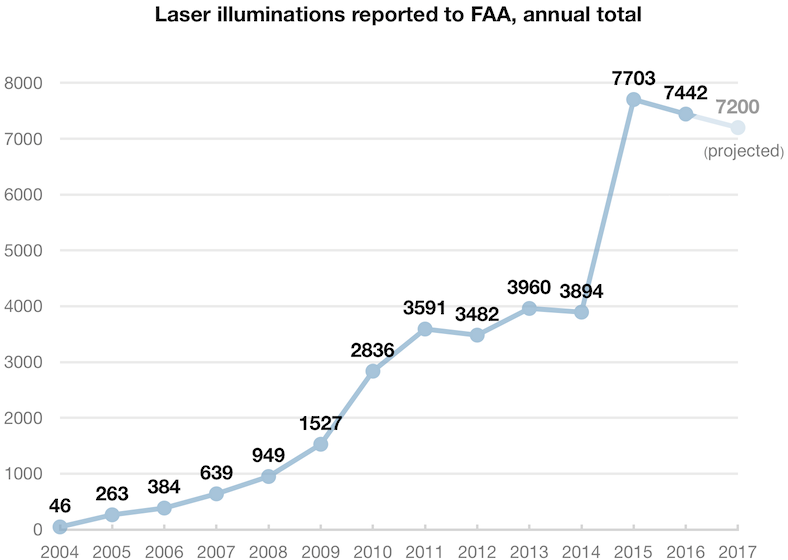
The next chart shows the number of laser illuminations per day. Each line is a different year. The lines have been smoothed by averaging the previous 30 days (a 30-day moving average). For this reason, the lines do not start until January 30.
This shows trends within a year. For example, in both 2016 and 2017 the number of reports dropped significantly in early May, while in 2015 the number of reports was more constant during that period.
The chart below shows the number of laser illuminations for every single day between Jan. 1 2007 and April 29 2017. The light spiky line shows each day’s illumination reports. This number can vary widely from one day to the next. The dark line is a 60-day moving average. This helps smooth out the data, in order to show longer-term trends.
From these charts, it can be seen that illumination reports grew slowly, or even declined, in the first few months of 2015, 2016 and 2017. However, in the final months of 2015 and 2016, the number of illumination reports picked up significantly. The estimate above (that there will probably be around 7,200 reports in 2017) takes this effect into account.
Statistical note: The careful reader will see that the blue 2017 line in the first chart falls between the 2016 and 2015 lines. Yet LaserPointerSafety.com predicts 2017 as a whole (Jan-Dec) will be lower than both 2016 and 2015. This is because we used all ten years, 2007-2016, to estimate the year-end total as a proportion of the first six months. Both a simple average of these ten years, and a weighted average — where more recent years have a larger effect — indicate that the 2017 total will be in the ballpark of 7,200 illuminations. In other words, 2015 was an atypical year where illuminations in the last eight months of the year grew much faster than any other year.
US: Study shows FAA-reported eye effects or injuries for four recent years
The data shows that pilots reported eye effects or injuries in less than 1% of laser illumination incidents. Flashblindness was the most-reported effect, followed by “Pain, burning or irritation in eye.” Blurriness was also frequently listed, along with unspecified “eye injury.”
In 20% of eye effect/injury cases, the person affected sought medical attention.
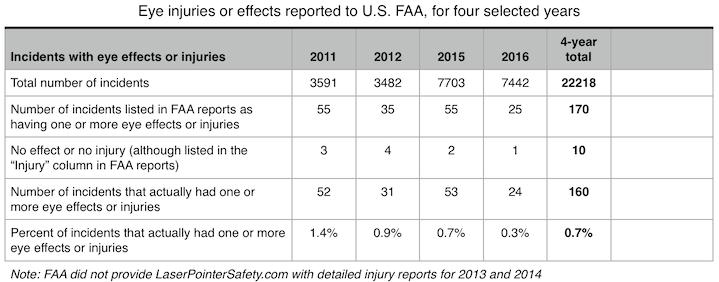
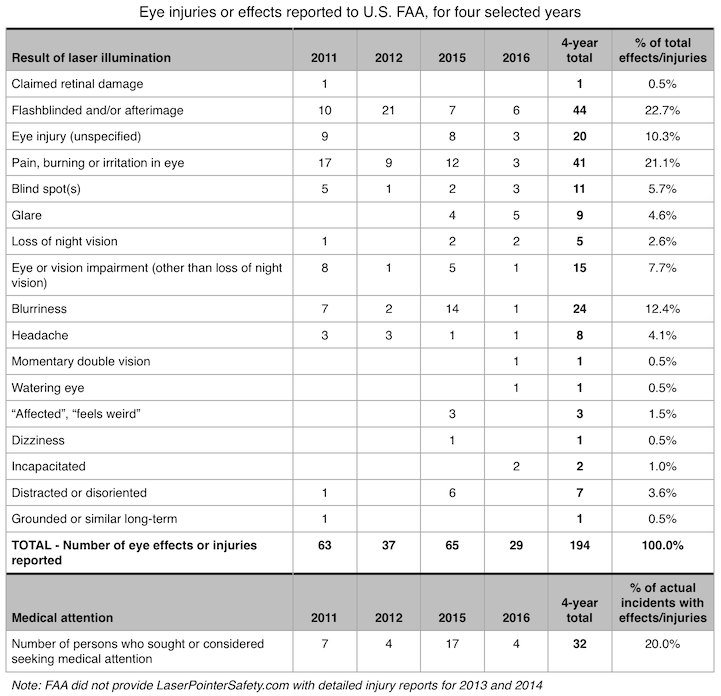
From the FAA weekly Laser Report
US: UPDATED - 7,442 laser incidents in 2016; slight decrease compared to 2015
According to FAA data, there were 7,442 laser illuminations reported by pilots in 2016. This is a slight decrease of 3.5%, compared to 2015. However, both 2015 and 2016 had far more incidents than the previous four years, 2011-2014.
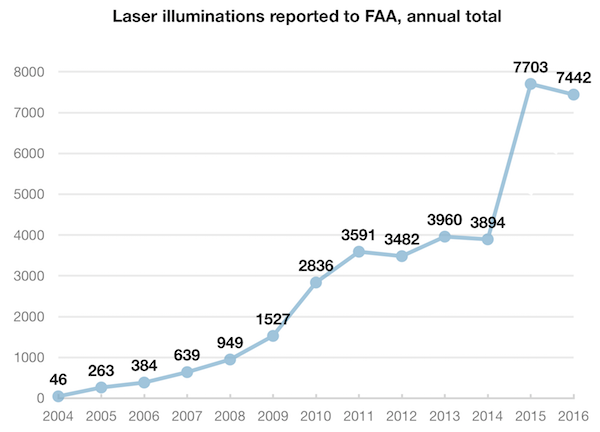
Here is the same data, arranged to show the average number of incidents per day:
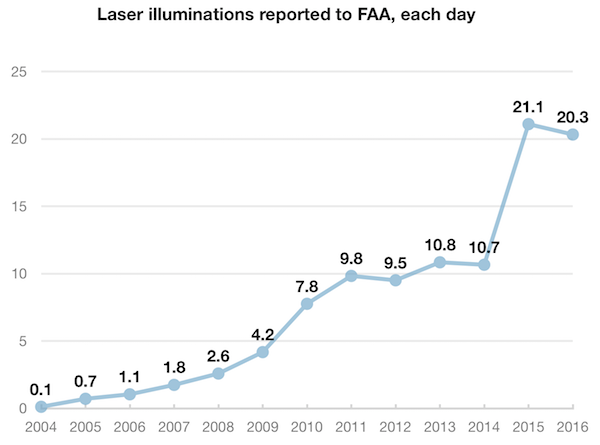
Laser color(s)
As in previous years, green was by far the most-reported color:
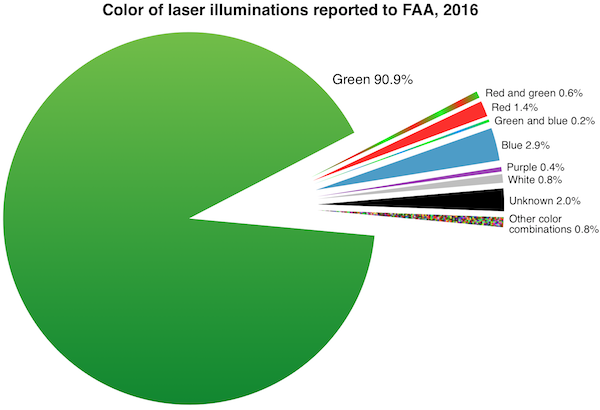
An October 2016 U.S. Food and Drug Administration proposal would allow the manufacture of laser pointers only in the 610-710 nanometer wavelength (orange-red to deep red). This chart shows the 2016 laser illuminations arranged according to those colors:
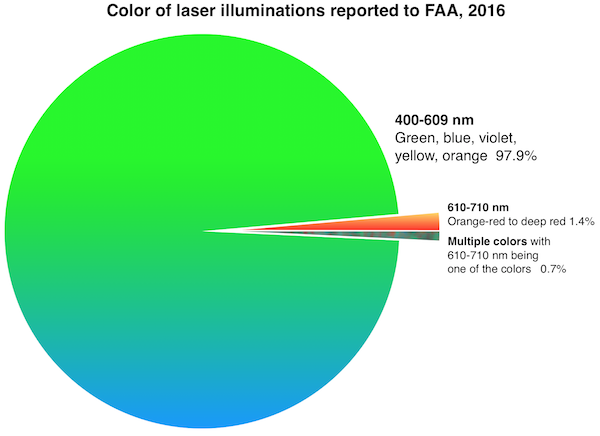
Eye injuries or effects
There were 24 laser illumination incidents in 2016 where eye effects or injuries were listed. This is 0.32% of the total number of incidents. These are the effects listed; the total adds up to more than 24 due to multiple effects in some cases.
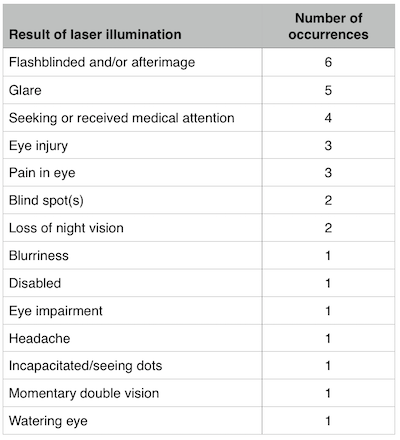
From the FAA weekly Laser Report, January 9 2017 with data January 1 - December 31 2016
US: FAA Eastern Region warns against holiday & Christmas laser light display misuse
The full text of the statement is as follows:
“The FAA’s concern is that lasers -- regardless of the source -- not be aimed at aircraft where the beams can threaten the safety of a flight. Consumers who buy laser light displays should take precautions to make sure that the lights are hitting their houses and not shining off into the sky. In situations such as this, we would start by asking the person to either adjust them or turn them off. For more information on lasers, please go to www.faa.gov/about/initiatives/lasers/“
From an FAA Eastern Division email to LaserPointerSafety.com, and from the Boston Globe. LaserPointerSafety has run previous stories about Christmas and holiday laser lights such as the Star Shower, since they first became popular in 2015. Click for stories about aviation incidents and for general stories about the lights and their potential hazards.
US: FAA bill mandates quarterly reporting of laser incidents and prosecutions; increases civil penalties
- the number of laser pointer incidents reported to FAA
- the number of civil and criminal enforcement actions
- the resolution of any incidents that did not result in a civil or criminal action
- any actions taken to help deter laser pointer incidents
In addition, the maximum civil penalty that FAA can impose was raised to $25,000. It was formerly $11,000.
U.S. Government Printing Office. The full text of the laser pointer provisions of the Act is below (click the Read More… link).
Click to read more...
US: Statistics for second half of 2015 show unusual rise and sudden decline
The chart below, showing FAA laser illumination reports for the past nine years, demonstrates how the number of reports increased and even more dramatically decreased (yellow area):
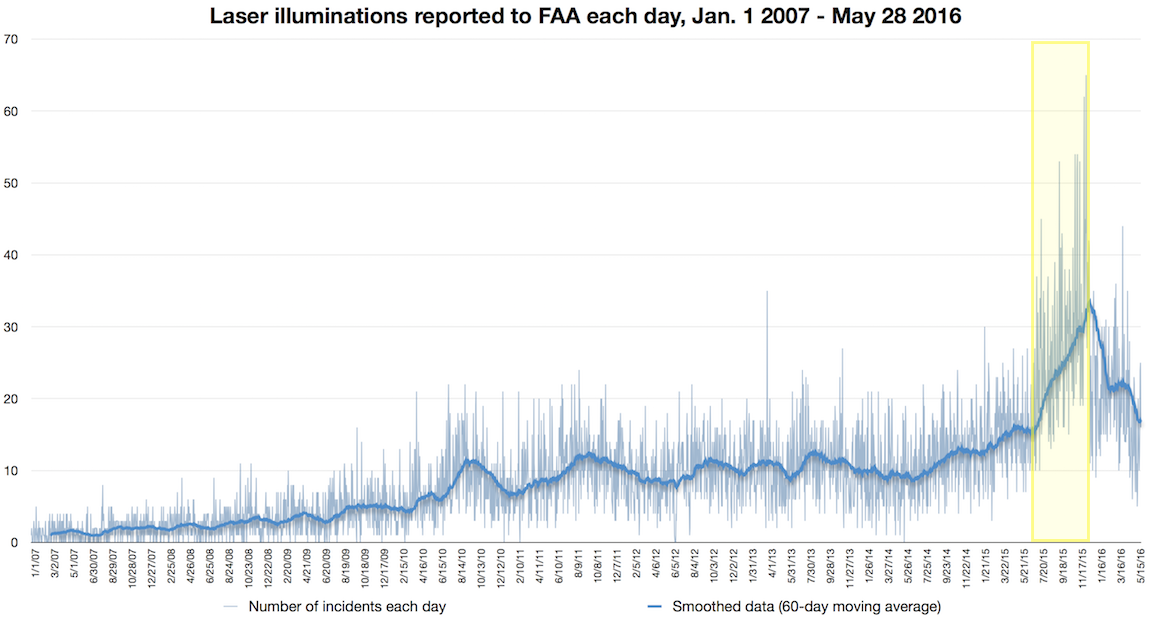
Click for larger image
A closer look at the past two years shows this more clearly:
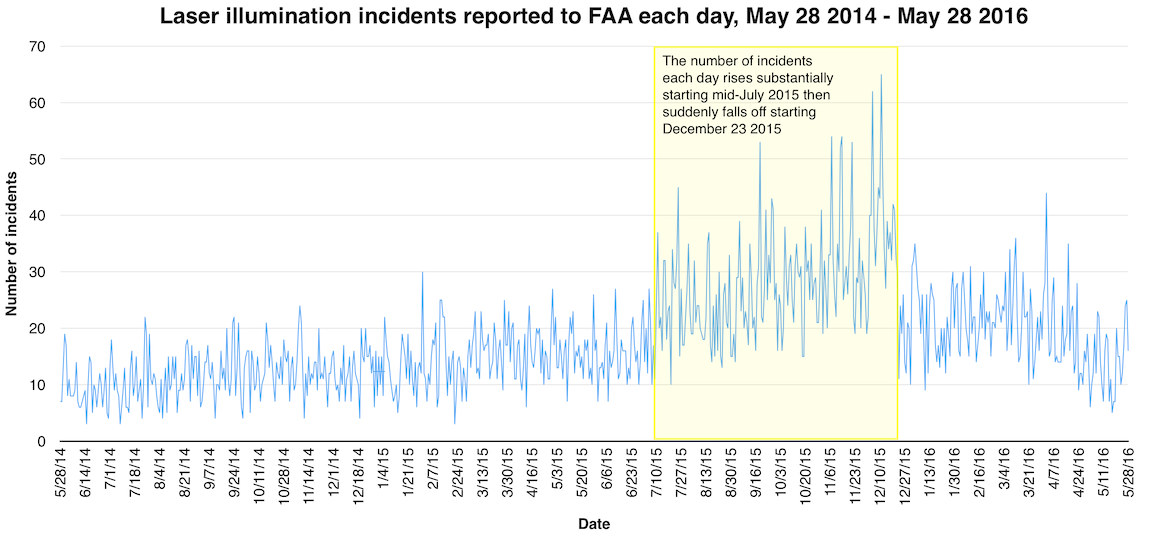
Click for larger image
A possible cause of the increase is that on July 16 there was widespread nationwide publicity about 11 flights that were illuminated on July 15 in and around New Jersey.
However, this event is not a full explanation. While the publicity may have triggered a “copycat” effect, incidents had been increasing at least two weeks prior to July 16.
LaserPointerSafety.com is not aware of any other external events such as new laser pointer products, changes in laws, etc. that could also account for this increase. And, we have no explanation for the dramatic fall-off starting December 23. We have reached out to FAA to find out if there were any changes in pilot reporting requirements or in data gathering procedures.
Knowing reasons for the increase — and especially for the sudden decrease — could provide clues in the effort to reduce laser pointer incidents in the U.S.
US: UPDATED - 2016 laser incidents up 33% over same period in 2015
From January 1 through May 28 2016, pilots filed 2,925 reports of laser illuminations with the U.S. Federal Aviation Administration. This is a 33% increase over the 2,194 reports filed during the same period in 2015.
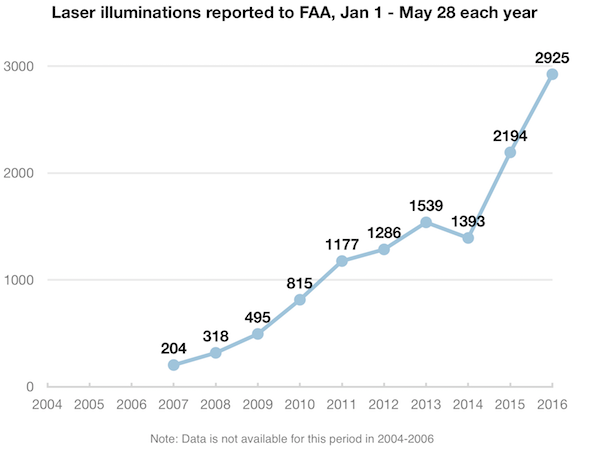
LaserPointerSafety.com estimates there will be over 8,500 laser incidents reported for 2016. This is based on comparing the number of illuminations Jan 1 - May 28 2016, with the average of the same period in the past four years.
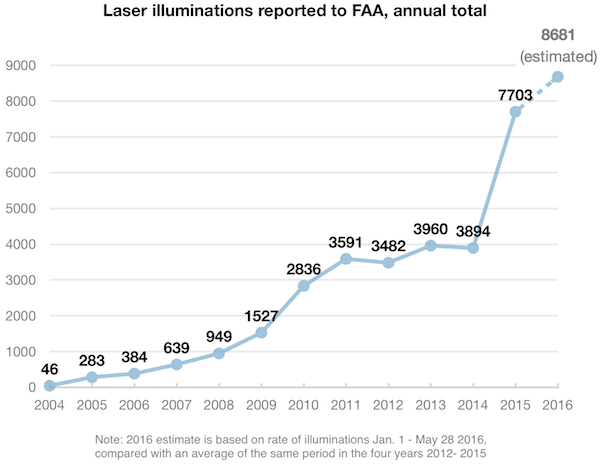
Canada: 663 laser/aircraft incidents in 2015 based on newspaper analysis of CADORS data
Here is the CADORS data:
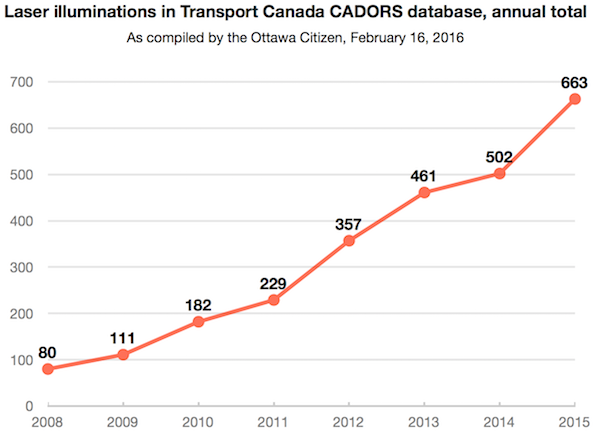
Compare this with the number of illuminations in the United States over the same period:
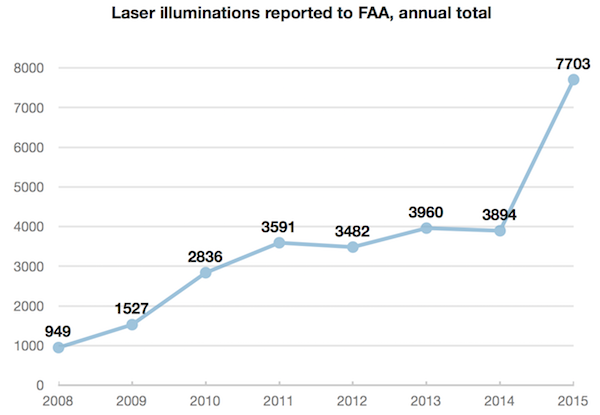
Canada’s data roughly tracks the U.S. data. Here are the two charts above, superimposed, with the CADORS numbers multiplied 11.7 times. The slope of the lines are similar for all but 2013/2014, and the endpoints are remarkably close.
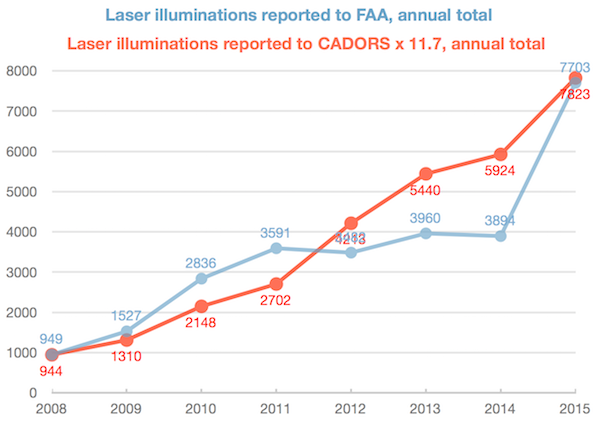
From an analysis by Andrew Duffy in the Ottawa Citizen. Note that a few days earlier, CBC News stated that there were 590 laser/aircraft incidents in 2015. There is no indication as to reasons for the discrepancy.
US: UPDATED - Laser incidents nearly double in 2015 to 7,703
he number of FAA-reported laser incidents nearly doubled in 2015, to 7,703. This is a significant increase over the 2010-2014 period, which had hovered around 3,500-4,000 incidents per year.
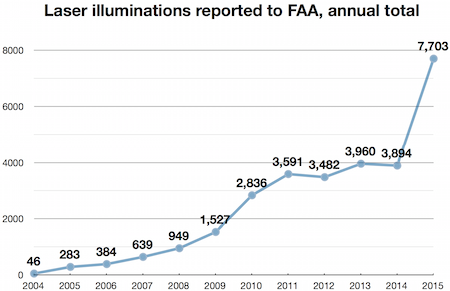
Here is the same data, presented to show the number of incidents per day:
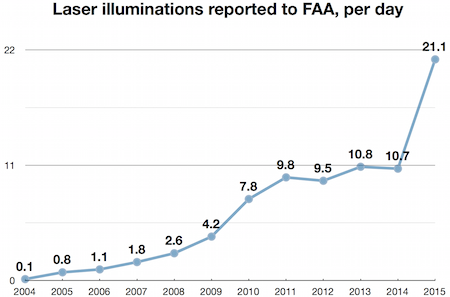
Below is a closeup of the 2014-2015 data. The thin light blue line represents the number of incidents on each day. Note the wide variability, from as few as no reports in a day (May 27 2014) to as many as 65 on December 11 2015.The thick blue line is a 30-day moving average, to smooth out the data.
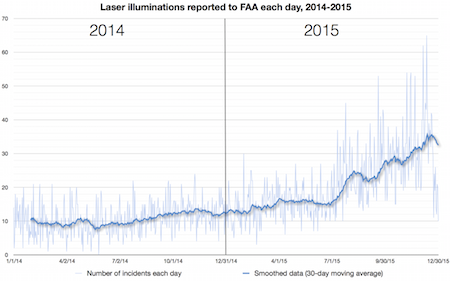
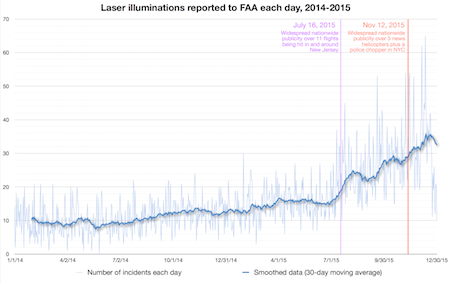
Both charts show identical data. On the second chart, two dates have been highlighted. Around July 1 2015, the number of incidents per day (light blue line) starts to increase. The only significant change that LaserPointerSafety.com can find around that time, is that on July 16 (purple line) there was widespread nationwide publicity about 11 flights that were illuminated on July 15 in and around New Jersey.
However, this event is not a full explanation. While the publicity may have triggered a “copycat” effect, it is apparent from both the thin and thick lines that incidents had been increasing at least two weeks prior to July 16.
Another date with widespread nationwide publicity is marked, November 12 2015 (red line). Three news helicopters and a police helicopter were illuminated in New York City the night before. Again, while there is some increase in incidents after that date, there also was a consistent increase from July through November.
Based on this analysis, “Copycat” laser use does not seem to be a significant factor in the near-doubling of 2015 laser incidents.
US: Study of U.S. incidents, 2010-2014 gives insights into laser-aircraft safety
An AirSafe summary noted that from 2010 through 2014, there were only eight days with no laser encounters reported in the U.S. The graph below shows the distribution of incidents, with most days having between 7-12 laser strikes:
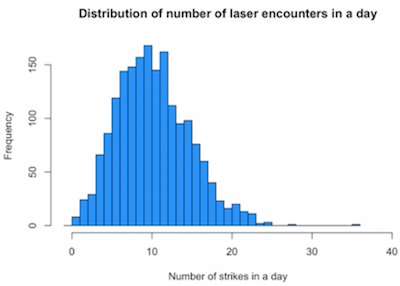
Analysis by day of the week, and by month of the year, showed Friday and Saturday evenings as having a greater likelihood of illuminations. July through November saw higher-than-normal numbers of incidents.
The AirSafe study also looked at six selected metropolitan areas. It compared the number of flights to the number of incidents. Phoenix, Los Angeles and San Francisco had higher-than-normal numbers of incidents; Chicago and New York were about average, and Atlanta was below average.
From AirSafe.com: summary page, and detailed analysis as a webpage, PDF and RPubs versions. Links are given to the raw FAA data, the processed version used by AirSafe, and statistical R code. Thanks to Dr. Todd Curtis who did the study and brought this to our attention.
US: UPDATED - "Star Shower" home laser projector raises aviation concerns
Between November 18 and December 6 2015, there have been at least three incidents, involving six aircraft, where pilots were illuminated with light from “Star Shower” laser projectors. In all cases, the illumination appeared to be inadvertent. The devices were being used for holiday decorating, and stray beams went into airspace. (E.g., a person was not knowingly aiming the Star Shower at an aircraft, or the flight path of an aircraft.)
The Star Shower emits “thousands” of laser beams from two sources, one green and one red. A homeowner can simply aim the Star Shower at her house or foliage, and instantly cover it with green, or green plus red, laser dots.
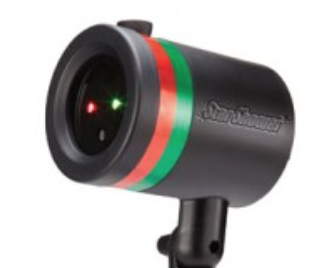
The projector head. It screws into a stake that is placed in the ground for outdoor use.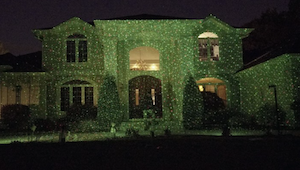
A home densely covered with laser “stars” from multiple Star Shower projectors. Both photos from the Star Shower website.
According to a comprehensive story in Inquisitr, Star Shower is so popular that it is sold out in many locations. TravelPulse calls it a “laser cannon.”
The Federal Aviation Administration on December 8 2015 tweeted “Decorating for the holidays? A stray laser could blind a pilot.” They then provided a link to general information about laser/aviation safety. An FAA spokesperson told CBS Philly, ““I don’t think anybody who buys these devices even think they have enough power to hit an aircraft in the sky…. If the box is aimed a little high, some of the lasers will not hit the roof of the house, they’ll keep going into space.”
While there is no warning on the outer packaging, the Star Shower instruction sheet says: “NOTICE: Lasers should not be projected at or within the flight path of an aircraft within 10 nautical miles [11.5 miles] of an airport. If your intended surface is within 10 nautical miles of an airport, lower the angle of the Star Shower so that no lasers point into the sky.”
In a December 9 2015 statement to NBC Los Angeles, the manufacturer added: “Star Shower Laser Lights operate by taking a single laser beam and diffracting it into thousands of individual laser beams. Each beam emitted by Star Shower is much lower in power than a typical laser pointer. Each individual laser beam is 10 times less than the maximum permissible exposure (MPE) allowed by the FAA normal flight zone (NFZ) criteria.”
In an urban or suburban environment, it is likely that most homes are within 10 NM of some type of airport. It may not be a major metropolitan airport; it could be a small general aviation facility. In a December 3 2015 incident, a Boeing 737 at 13,000 feet and 22 miles east of Dallas-Fort Worth Airport, reported seeing lights from what was believed to be a “laser holiday light display.”
From the FAA, Inquisitr, NBC Los Angeles
Analysis and commentary by LaserPointerSafety.com
ADVICE FOR OUTDOOR USE
After purchasing and testing a Star Shower, here is our summary advice for consumers. Details then follow.
The Star Shower is essentially eye-safe, and does not cause direct interference (glare) with pilots’ vision after about 411 feet. However, a single beamlet can be a distraction to pilots at least 3/4 of a mile away, and possibly further away due to the large number of laser dots aimed into the sky causing a flashing effect.
For this reason, a Star Shower needs to be aimed so that beams don’t go into airspace. You do not want an officer knocking on your door because a pilot saw and reported your home laser projector. While it is unlikely you would be arrested for an unknowing aircraft illumination, federal penalties for laser pointer misuse range up to five years in prison and up to a $250,000 fine.
Putting the projector closer to a house will keep more of the beams on the structure. Similarly, don’t aim it up into a tree unless the tree is very dense, such as an evergreen.
It should also be noted that there are reports such as this and this of Star Showers being stolen from yards. If you put your projector on a roof or up in a tree, aiming downwards, this both helps aviation (no beams going up into the air) and makes it harder to steal the projector. Finally, if you are in a heavy air traffic area, you might want to consider restricting it to indoor use only.
IS A STAR SHOWER LEGAL?
Under U.S. federal law, the Star Shower is legal to own and operate. As a Class IIIa (3R) laser, there are no federal restrictions on its use. The federal law prohibiting laser pointer misuse may not apply, for two reasons. 1) It prohibits knowingly aiming at an aircraft or its flight path, and 2) the law applies to “laser pointers…designed to be used by the operator as a pointer or highlighter….” This definition would not seem to apply to a device that is not a pointer, and is not used “…to indicate, mark, or identify a specific position, place, item, or object.”
A few states or localities may have restrictions on lasers that would affect Star Shower. Since it is not a laser pointer, and is not used for pointing, restrictions that cover laser pointers may not apply (depending on the exact definition). Some selected state and local laws are here.
Common sense says that a person should not stare into the beams, and that they should not be aimed to harass others. Similarly, the beams should not be aimed down a road or up into the sky, where they could interfere with drivers or pilots.
PURCHASING AND PACKAGING
In early December 2015, we purchased a Star Shower for $40 from a CVS drugstore. The box lists a sales website at BulbHead.com, and the distributor as Telebrands. It also says “Made in China.”
Both the box and the device have the proper FDA-mandated laser safety labeling. The device is FDA Class IIIa, meaning less than 5 milliwatts output. There are two apertures, one for 532 nm green laser beams and one for 650 nm red beams. A diffraction grating in front of each laser breaks the single beam into dozens or “thousands” of less-powerful beamlets. In a foggy or smoky environment, it is possible to see the beamlets in the air, but they are too weak to be seen in clear air.
Although the Star Shower has been popular for the Christmas 2015 season, the packaging does not emphasize this. Instead it says the Star Shower is “great for” indoor, landscaping, holiday, winter and summer uses. The advantages are: “No ladders, no hanging, no dead bulbs, no mess — just plug it in.”
TESTING
We took it to laser expert Greg Makhov of Lighting Systems Design Inc. for testing. Keep in mind that he tested just this one sample unit; we assume it is representative of the other Star Showers that have been sold.
Makhov used two different types of power meters, both which could measure in the microwatt and milliwatt region. He found that the maximum power of a single beam was 0.4 milliwatts. The chart below shows details.
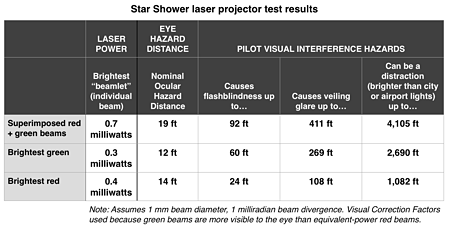
ESSENTIALLY NO EYE INJURY HAZARD
The brightest single beam, at 0.4 mW, is below the 1.0 mW Class II limit. Class II laser pointers are generally considered to be safe for accidental exposure. Eye injury from a Star Shower would be almost impossible unless a person at close range deliberately overcame his aversion to bright light and stared for many seconds into one of the beamlets, keeping it at the same spot in his visual field.
While the chart shows the Nominal Ocular Hazard Distance to be as far as 19 feet, keep in mind this is a “nominal” hazard. This does NOT mean that beams will cause injury at this distance. There is a kind of safety factor built in to the NOHD. A quick approximation is that at about 1/3 the NOHD (about 6 feet in this case), there is a 50-50 chance of a laser kept steady on the eye causing the smallest medically detectable lesion on the retina, under laboratory conditions.
GLARE UP TO 411 FEET, DISTRACTION TO 3/4 MILE
The chart also shows the visual interference hazard distances. For example, a pilot could experience veiling glare (she can’t see past the light) up to 411 feet away from the Star Shower projector. The light does not interfere with vision, but is a mental distraction, up to 4,105 feet away — a little over three quarters of a mile.
The above eye and visual interference calculations are for a single beamlet, for two reasons. First, at aviation distances, only one beamlet would enter the eye at a time. They are not so close together that two separate beamlets of the same color would be within one pupil diameter. The second reason is that even a person is so close to the Star Shower that two separate beamlets enter his pupil, each one will be focused onto a different area of the retina. This means that the beams don’t overlap — they are heating different areas. This is why we are primarily concerned — both for eye safety and for aviation interference — with the hazard of a single beamlet.
Now, when a helicopter flies through the dozens or “thousands” of laser beams, this can be more distracting than a single beam. It is no wonder that a pilot might report the laser display, and have it re-aimed or shut down.
Although an FAA spokesperson said a Star Shower was reported by a pilot who was at 15,000 feet, at this distance any single beamlet would be far below the FAA’s distraction limit. This means any beamlet would be no brighter than surrounding city or airport lights. It could be that the large number of beamlets caused flashes as the aircraft flew through them, and that this flashing was itself a distraction. Either way, no competent pilot at 15,000 feet should have any visual interference from a Star Shower. The only problem could be mental distraction, if the pilot paid more attention to the light than to flying the aircraft.
DISASSEMBLY AND HACKING (UPDATED DECEMBER 2016)
In early December 2016, Julius R. wrote to us wondering about the safety implications of opening the Star Shower and removing the star-creating holographic diffraction grating.
Our Star Shower, purchased in December 2015, has four security screws hidden behind rubber caps. The screws are at the bottom of a 2-1/4” deep shaft that is 5/16” in diameter. The screw head shape is a triangle with a raised dot in the center: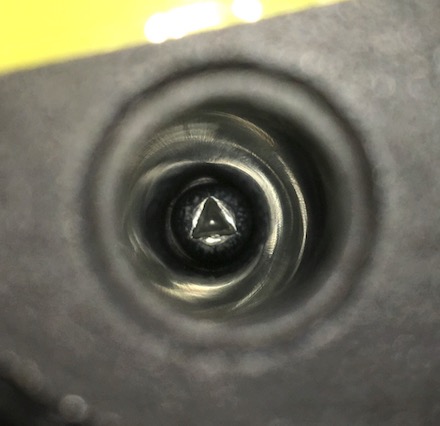
It would require a long screwdriver with a matching tip to reach and undo the screw. A brief search of Google Images to try to find such a screwdriver did not turn up any instances.
Certainly someone might be able to find such a tip, or to grind a shaft to fit. And breaking the Star Shower’s plastic housing could also give access to the inside. So if someone really wanted to get at the interior lasers, it would be possible.
We estimate that each of the lasers on the inside would be in the 10 to 50 milliwatt range. This power can cause an eye injury, although the injury would be relatively minor (assuming an unintentional exposure; deliberate staring into any laser beam should never be done). It is at the low end of Class 3B lasers.
There are similar lasers, and much more powerful ones, readily available online. They would be cost the same or even less, and would be much easier to use. So a laser hobbyist or hacker is unlikely to use a Star Shower as a source for red and green single-beam lasers.
In short, disassembly and misuse of the interior lasers is not a significant safety concern.
FOR FURTHER INFORMATION
Anyone with further questions can contact us; click the link below in the footer at the bottom of the page.
US: Slightly more than average number of laser incidents grabs media attention
Except for the involvement of multiple helicopters in New York City, the twenty November 11 overnight events were actually close to the current 2015 average of the 18.3 reported incidents per night.
It is normal for day-to-day incident numbers to fluctuate. For example, a day later on November 12, there were six incidents according to Slate.
Another example of the variability of daily incidents is shown by the day-to-day numbers for 2014. During the year there was an overall average of 10.7 incidents per day. The graph shows that daily numbers (light line) varied from 0 reported laser incidents to 24. (The dark line shows a 30-day moving average, to help smooth out the data. Day-to-day figures for 2015 are not yet available.)
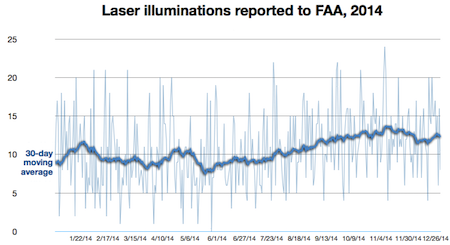
The U.S. Federal Aviation Administration made a Facebook post describing the November 11 incidents:
More than 20 aircraft were struck by lasers from the ground last night while flying over cities across the United States. Three laser strikes were reported in the New York City/Newark, N.J early in the evening, followed by three incidents in Texas, where jets were struck while preparing to land at Dallas Love Field. By late evening, pilots reported laser incidents in:
New York/Newark; Dallas; Jamestown, NY; Oakland, CA; Covington, KY; Danville, KY; Palm Springs, CA; Salt Lake City; Los Angeles; Albuquerque; Detroit; Ontario, CA; St. Petersburg, FL; Springfield, IL; San Juan, PR; Sacramento
None of the pilots reported injuries. Nevertheless, shining a laser at an aircraft is a federal crime that the U.S. vigorously pursues. Lasers distract pilots from their safety duties and can lead to temporary blindness during critical phases of flight, such as takeoff and landing. In some cases in the past, pilots have reported eye injuries that required medical treatment.
As of Oct. 16, the total number of laser strikes around the U.S. this year was 5,352.
Media stories that referenced the incidents included the following headlines and leads:
With new flurry overnight, laser strikes on aircraft hit record pace, USA Today
“Laser strikes on planes are growing even as the federal government enacts tougher penalties for people caught shining the devices. Overnight Thursday federal authorities fielded reports of more than 20 laser strikes on aircraft, adding to an already record-breaking number of strikes this year.”
Overnight outbreak of lasers pointed at aircraft, CBS Evening News
“The FAA says 20 aircraft were targeted by people with bright laser pointers Wednesday night in cities across the nation. Kris Van Cleave reports on the surge in these types of incidents.”
FAA: Lasers beams hit more than 20 aircraft overnight, Washington Post
“Federal authorities have launched an investigation after numerous aircraft were hit by laser beams Wednesday night. More than 20 aircraft were struck while in flight over at least 16 U.S. cities, according to a statement from the Federal Aviation Administration. Authorities said three strikes were reported to the FAA in the New York City area, followed by three in Texas that hit jets that were preparing to land.”
Lasers hit 20 aircraft flying in U.S. overnight - FAA, Reuters
“Dangerous beams from handheld lasers struck 20 aircraft flying over the United States and its territories overnight, among the nearly 5,400 laser hits in the nation so far this year, the Federal Aviation Administration said on Thursday. No injuries were reported in the incidents, which took place from New York City to Sacramento, and resulted in at least one arrest. Authorities said the incidents did not appear to be linked to each other.”
6 aircraft hit by lasers in New York, Dallas on Wednesday, Fox News
“Three news helicopters in New York and three planes near Dallas were hit by laser beams on Wednesday, according to the Federal Aviation Administration. Pilots for choppers flying for CBS New York, WNBC and WABC each described seeing a laser in their cockpit while flying over a scene in Park Slope, Brooklyn, CBS reported.”
High Number Of Laser Strikes In One Night Has Pilots Uneasy, CBS Sacramento
“The Federal Aviation Administration is looking into a series of laser strikes on aircraft across the country, including a possible strike at Sacramento International Airport. The exact details of that reported laser strike have not been made available yet, but for pilots these little beams of light are a huge concern. It was a busy night for law enforcement and air traffic control across the nation, with more than 20 pilots reporting laser pointers aimed at their cockpits.”
US: 96 FAA enforcement actions in two years
During this timespan according to agency records, there were 7,149 reported incidents. This means that the FAA investigated 2.1% of the incidents, and took enforcement action in 1.3% of the incidents.
There were no specific details about how many enforcement actions resulted in a conviction and/or penalty such as a fine or jail time. The agency did say in general that “Federal, state and local prosecutors have sentenced laser violators to jail time, community service, probation and additional financial penalties for court costs and restitution.”
The press release distinguished between accidental and deliberate use of lasers: “The FAA’s guidance for agency investigators and attorneys stresses that laser violations should not be addressed through warning notices or counseling. The agency seeks moderately high civil penalties for inadvertent violations, but maximum penalties for deliberate violations.
From the FAA’s Fact Sheet - Laser Strikes
US: From 6,500 to 7,100 laser incidents estimated for 2015
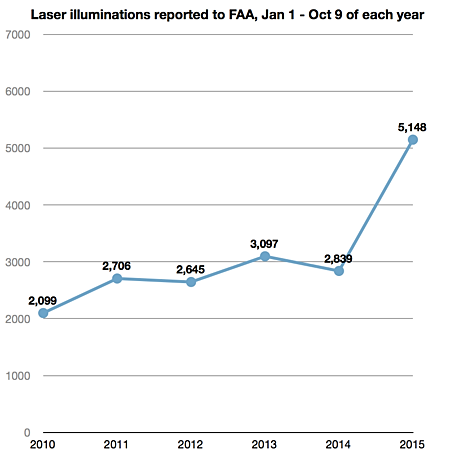
Based on trends in the years 2010 through 2014, this means that at the end of 2015 there could be between roughly 6,500 and 7,100 reported incidents. (The range is because in some years, the yearly total was between 1.28 and 1.37 times the Jan. 1 - Oct. 9 total.) We estimate that 2015 is likely to have roughly 6,850 incidents. This would be 176% of the 2014 total of 3,894 incidents.
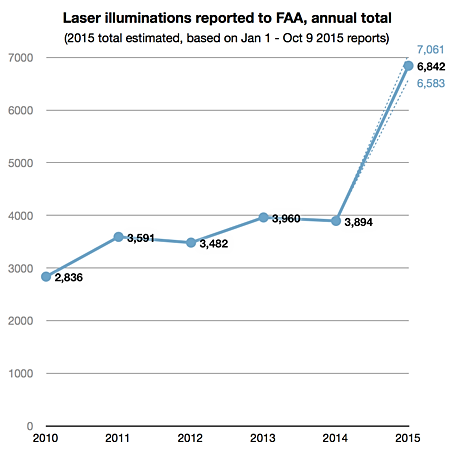
Stated on a daily basis, the number of reported incidents is expected to rise from 10.7 per day in 2014 to between 18.0 and 19.3 per day in 2015.
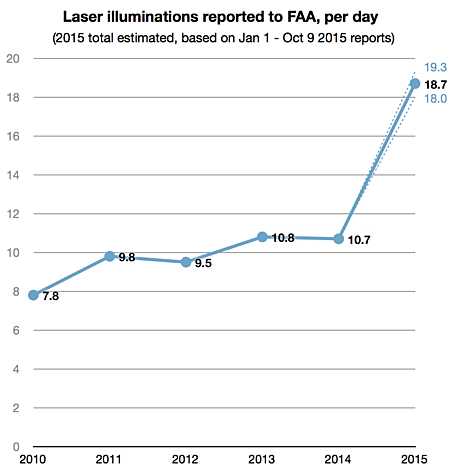
2015 information provided by FAA on November 5 2015. Statistical analysis done by LaserPointerSafety.com based on prior year FAA records.
US: Aviation reporter says FAA anti-laser efforts aren't working; wants more social media
Negroni began the segment by noting that laser incidents are “truly a menace and it’s not to be taken lightly.” She said offenders “don’t watch the news, they don’t read the paper” and thus “they need to be reached out on their level. And that level is like a Facebook level or a Twitter level, where people are actually going to learn.”
She concluded that “it’s just time for the establishment to get on board, before something really terrible happens.”
Negroni has written aviation articles for publications such as the New York Times and Smithsonian Air & Space, is an on-air expert for ABC, CNN and NBC, and has a book on mysterious aviation accidents coming out in 2016. She previously wrote an article for RGN critical of FAA laser publicity efforts entitled “No let-up in laser attacks on airplanes” published December 13 2013, and a blogpost on the same topic on August 28 2014.
From the Runway Girl Network podcast episode 27, “Crash Investigations and Laser Incriminations”, uploaded August 29 2015. A transcript of the laser-relevant parts of the podcast is below.
Click to read more...
US: FAA says no known permanent eye injuries from laser pointers as of March 2015
Commentary from LaserPointerSafety.com: There have been many pilot claims of eye injuries caused by laser pointers aimed at their aircraft. FAA has investigated some of the most serious claims. In 2011, a person knowledgeable about these studies told LaserPointerSafety (on background): “I haven't seen anything that convinces me that any of the FAA incidents are true injury. I haven't seen any convincing evidence of delayed laser lesion effects. I do know that headaches and eye pain and photophobia and light sensitivity have been reported and associated with laser illumination. I have seen nothing convincing me that there is real cellular, tissue injury.”
There have been a few cases (<10?) of temporary eye injury, where the eye healed. This is similar to how skin can heal after a sunburn. In all of these cases, the pilots returned to flying.
There have also been cases of reported laser injury to the cornea. This is the transparent surface of the eye. Visible laser light passes right through and is not absorbed. The cause of these reported “laser” injuries is the pilot rubbing his or her eyes too vigorously, causing painful scratches in the sensitive cornea. Any damage from a visible laser beam would be on the light-absorbing retina.
Note that FAA limited its statement to commercial pilots. There may be military pilots in conflict zones who have been injured by laser weapons. If so, this information would be classified. Due to the seeming lack of urgency with FAA and U.S. military, any such injuries would not seem to be a threat to commercial pilots in the U.S.
Here are lists of all LaserPointerSafety.com news items tagged with the keyword “eye effect or injury”: aviation injury incidents, non-aviation injury incidents, other eye injury stories.
LaserPointerSafety welcomes any documented cases of pilot eye injuries. Contact us with the links etc., and also contact FAA so they can be aware of the cases.
US: FAA-reported laser incidents up significantly in 1st half of 2015
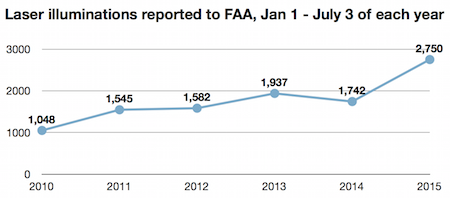
Based on past years’ trends, this means that at the end of 2015, there could be between about 5,600 and 7,400 incidents. (The range is because in some years, the second half of the year had 2.04 to 2.71 times the number of incidents in the first half.) We estimate 2015 is most likely to have about 6,300 incidents. This would be a 62% increase over the 2014 total of 3,894 incidents. 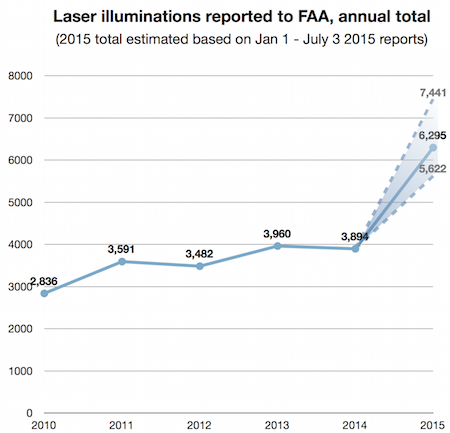
Stated on a daily basis, the number of incidents is expected to rise from 10.7 per day in 2014 to somewhere between about 15 and 20 incidents per day in 2015: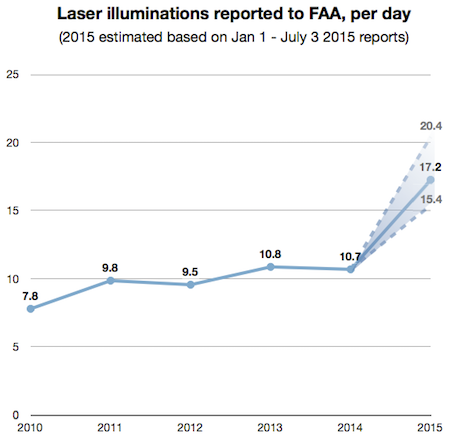
2015 information provided by FAA on July 10 2015. Statistical analysis done by LaserPointerSafety.com based on prior year FAA records.
US: FAA releases spreadsheet with details of laser incidents, 2010-2014
This information was previously restricted and hard-to-obtain by the general public. The 3.6 MB Excel-format spreadsheet lists the date, time, aircraft ID, aircraft type, altitude, nearest major city, beam color, and whether an injury was reported.
The image below shows four days worth of data, January 1 through 4, 2014. Each row is one laser/aircraft incident.
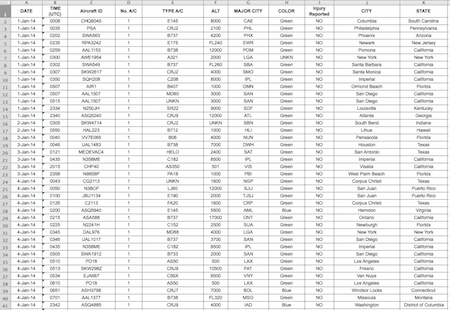
The spreadsheet, “Reported Laser Incidents for 2010-2014”, can be downloaded from FAA’s webpage Laser News, Laws, & Civil Penalties.
US: 3,894 FAA-reported laser illuminations in 2014; only 2.4% decline from 2013
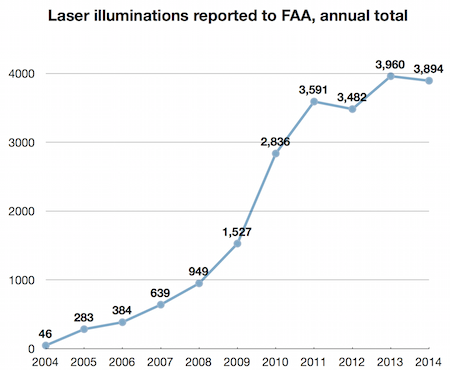
The chart below shows the number of incidents each day (light blue line) and a 30-day moving average (dark blue) to smooth out the data. In the first half of the year (Jan 1 - Jun 30) there were 9.4 incidents per day, but these rose in the second half to 11.9 incidents per day, making the 2014 final average of 10.7 incidents per day.
It is unclear why 2014 saw roughly level incident rates up to about June but then a steady increase over the next 5 months. One significant 2014 event was the February push by the FBI to publicize and prosecute laser pointer incidents, including offering a $10,000 reward. This was followed by another FBI push in June — after which rates started to rise.
The chart below shows 2014 in context with the past seven years. While the incident rates have leveled off to about 10-11 per day since 2011, all the publicity and prosecutions over the past few years have not brought the rate downward.
Finally, this chart superimposes each year’s laser illumination incidents, from 2009 through 2014. This gives an idea of the “shape” of each year. The heavy black line is 2014 data.
From public FAA Excel spreadsheet “Reported Laser Incidents for 2010-2014” at this page. For 2013 and previous years’ data, see the page FAA laser/aircraft incidents: 2004-2013 historical data.
Arizona: Pilots will seek to upgrade laser pointing penalty to felony
The first draft of the April 2014 law called for a Class Five felony to “knowingly or intentionally” aim a laser towards an aircraft. But there was concern among legislators that juveniles could end up with a felony record. The bill passed once the penalty was reduced to a Class One misdemeanor.
In a September 22 2014 story, reporter Emilie Eaton recounted Arizona’s experience. FAA-reported incidents in the state rose from 138 in 2010, to 202 in 2013. One police pilot interviewed said that he had been hit by lasers over 100 times, during a 22 year career. The pilot, Chris Potter, said he had permanent damage from a laser strike: “It literally felt like I got punched in my eye and there was a piece of debris, like a piece of glass in my eye.”
Another pilot quoted, Pima County Sheriff’s Department deputy Chris Janes, said he has has between 12 and 24 laser strikes from 2007 to 2014: “I have not received any eye damage. But I’ve had headaches afterward. I’ve had eye discomfort for several days afterward.”
From Cronkite News, via the Tucson Sentinel
US: Wall Street Journal article describes laser pointer hazards to aircraft
The article begins by saying that “People keep aiming powerful laser pointers at aircraft ... despite jail sentences for offenders and rewards for people who turn them in.”
It quotes unnamed law enforcement experts and prosecutors as saying that most strikes are “not done out of maliciousness, but irresponsibility.” The FAA told the WSJ author that no accidents or aborted takeoffs or landings have been attributed to laser incidents.
Jones notes that the FBI’s recent publicity and prosecution campaign “appear[s] to have led to some success, with the number of laser strikes in recent months dropping to about nine a day from about 11 in 2013, according to an FBI spokeswoman. She said this crime was the first for which the FBI has offered a reward that didn’t involve a fugitive or missing person.”
The article describes a few cases, then in the penultimate paragraph, states “Still, thousands of laser strikes, particularly involving commercial planes, go unpunished. Since 2005, only 162 people have been arrested for strikes, and 86 convicted, according to the FBI.”
From the Wall Street Journal. The article may be behind a paywall, requiring a subscription to access the full text. Aviation reporter Christine Negroni was moved by the WSJ article to respond a day later with a blog post entitled “Aviation’s Effort Combating Laser Attacks Hashtag #Ineffective #Insane”.”
US: UPDATED - Reporter questions effect of FAA/FBI "blame and shame" campaign
She disagrees with the U.S. government’s primary focus being a “blame and shame” campaign that tries to capture laser perpetrators using helicopters, then prosecutes them and publicizes the resulting multi-year sentences. Negroni calls this a “high-tech, heavy-metal, dollar-intensive approach to the problem … [that] has gone terribly wrong…”
Her contention is that persons who aim at aircraft “don’t watch television news, read the daily newspaper or log on to the FAA laser education website before heading out into the night with their nifty green or blue laser pointers.”
She ends her blog post by calling for creativity to try to market this message to its target audience of teens and young men, using a more sophisticated publicity or social media effort.
In the past few years Negroni has written about what she calls “this disaster in the making” for the New York Times, MSNBC, and the Smithsonian’s Air & Space magazine. Late in 2013, she wrote a more detailed article for the blog Runway Girl Network, exploring the problem — and suggested solutions — in more depth.
From Flying Lessons. Background information disclosure: LaserPointerSafety.com provided some information to Negroni which was used in her articles.
UPDATED September 8 2014 - Negroni’s blog post was reprinted by the Huffington Post.
US: FAA-reported laser incidents decline 12.8% compared to 2013
During the 219 days from January 1 to August 7, 2014, there were 2,085 laser incidents reported to the Federal Aviation Administration, according to the FBI data. This is a 12.8% reduction compared with 2,390 incidents during the same 219-day period in 2013, and is an 8% increase compared with 1,925 incidents Jan. 1- Aug. 7, 2012.
One reason for the decline may be the FBI’s campaign to prosecute offenders, and to inform the public via press releases and public service announcements that it is illegal to aim a laser at aircraft.
Based on the Jan-Aug 2014 data, the number of illuminations in 2014 is expected to fall below 3,500.
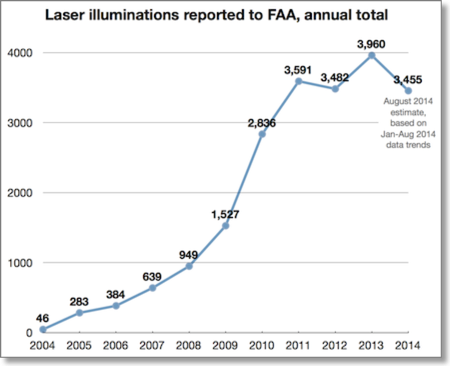
From information provided to LaserPointerSafety.com, and analysis of FAA data for previous years. For 2013 and past years’ data, see the page FAA laser/aircraft incidents: 2004-2013 historical data
US: Appeals court says federal prosecutors do not need to show intent in laser cases
The 8th U.S. Circuit Court of Appeals on Friday rejected Michael Smith's defense that he didn't believe the laser would reach the airliner, saying federal law doesn't require prosecutors to show he intended to hit the aircraft.
Below is more information, including a summary of the court’s decision and a link to the full decision.Click to read more...
US: 134 laser arrests, 80 convictions, out of 17,725 incidents, 2005-2013
Farivar noted that there were 80 convictions among the 134 arrests. One reason for the conviction rate of 60%: some who were arrested were minors who were never formally charged.
The extensively researched 4,200-word article, dated May 21 2014, was based around the 14-year sentence handed down in March 2014 to Sergio Rodriguez, for his August 2012 aiming of a laser at two helicopters, one medical and one police. Farivar used the case to illustrate many laser/aviation issues, especially about how prosecution is being used to try to educate and deter future incidents.
Farivar interviewed Karen Escobar, who has brought more cases against laser perpetrators than any other federal prosecutor. Her territory includes Sacramento, Fresno, and Bakersfield.
In the article, Escobar was quoted as saying “At sentencing, [Rodriguez] did not accept responsibility for his actions; he blamed his 2- and 3- year-old children. I believe the evidence showed the laser was a dangerous weapon, and there was intention, supporting a guideline sentence of 168 months. I would not call it harsh. I would say it is a penalty that fits the crime, but I believe that it will have a deterrent effect, and I hope it will.”
Farivar noted that, “While 14 years might sound incredibly excessive for an incident that caused no serious or lasting physical injury, much less death, this is the emerging reality for attorneys prosecuting laser strikes. The Rodriguez sentence now serves as an example of what can happen to defendants who don't take plea deals. (The plea deals typically end up being around two years.)”
From Ars Technica
US: 3,960 laser incidents reported to FAA in 2013
Other news based on the statistics:
- In 2013, there were no incidents documented by FAA as causing eye injuries. Although there were incidents with eye effects such as temporary flashblindness, afterimage, blurry vision, eye irritation and/or headache, no incidents were serious enough to be tabulated as “eye injuries” by the agency. The FAA did say that in 2013, there were 35 incidents where pilots who were lased sought medical attention.
- The closer an aircraft is to the ground, the greater the likelihood of reporting a laser incident. There is a strong peak in the number of incidents at 1000-3000 feet above ground level.
- The color green was reportedly seen in the vast majority (92.8%) of incidents. Blue was a distant second with 2.4% of incidents.
- For states, California had the most incidents (734), followed by Texas (416) and Florida (326).
- For cities and regions, LaserPointerSafety has determined the Los Angeles area, including Van Nuys and Burbank, leads the nation with 147 incidents. Portland Oregon is second with 137 and Houston is third with 124. (Note that LaserPointerSafety.com tabulates regions slightly differently than the FAA or FBI, so these federal agencies may have slightly different numbers or rankings.)
- FAA tabulates each incident according to the closest airport. For 2013, Portland (Oregon) International led this category with 133 incidents. Phoenix Sky Harbor International was second with 111, and Marin International in San Juan, Puerto Rico was third with 107. This does not necessarily mean that incidents occurred at or near these airports -- just that these were the closest airports to the reported incident.
Full details are on the 2013 laser/aircraft incidents page.
US: FAA prosecutes 1.5% of all laser/aircraft incidents
This appears to describe civil cases brought by FAA based on violations of 14 CFR 91.11, which states “No person may assault, threaten, intimidate, or interfere with a crewmember in the performance of the crewmember's duties aboard an aircraft being operated.” The maximum penalty is an $11,000 fine. FAA announced on June 1 2011 its intent to charge laser perpetrators under this law, so the 129 cases referenced above would be since that time.
During the same time period, from June 2011 to September 2013, there were 8,507 reported laser/aircraft incidents in the U.S. This means that 1 out of every 70 reported incidents results in a civil prosecution. Stated another way, 1.5% of all laser/aircraft incidents result in a civil prosecution.
Click to read more...
US: Latest FAA statistics show 3,188 incidents, Jan 1 to Oct 17 2013
The 2013 figure of 3,188 laser/aircraft incidents is 16.7% higher than the same period in 2012. If incidents continue at the same pace, there will be 4,063 incidents in calendar year 2013.
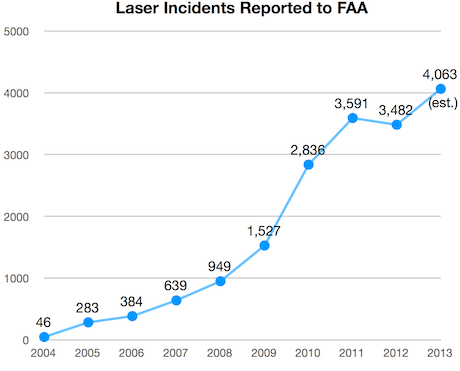
Total Incidents, 2004 to Date
There have been approximately 16,936 laser/aircraft incidents reported to FAA, from January 1 2004 through October 17 2013.For additional details on previous years, see the year-end statistics for 2012, 2011 and 2010.
Commentary from LaserPointerSafety.com
This 16.7% increase represents a setback from the 2012 totals, which were 3% lower than in 2011. Having a rise in 2013 incidents seems to indicate that the publicity and prosecutions which form the majority of current U.S. anti-laser efforts are not having the desired effect.
There has been some speculation that the 2013 figures differ from 2012 in part because FAA may have updated its incident reporting procedures. While FAA is working to include military and overseas incidents, this has not yet been done. In this respect the 2013 figures are directly comparable to earlier years.
Another possible explanation is that pilots have become more aware of the issue and are thus more likely to report a laser sighting. However, pilot information has been widely available since 2008 and has increased as this became of more concern. By now, most pilots should be alerted to the issue and FAA’s reporting requirements. There has not been a major push during 2013 in this area, so increased pilot reporting is probably not a major factor in causing 2013 reports to increase over 2012.
US: FAA updates laser reporting method in AC 70-2A
The changes include:
- Air Traffic Control can now regard a laser illumination of aircraft incident as an “in-flight emergency”, due to the potential debilitating injuries which could compromise safety and interfere with aircrew duties.
- New web-based methods by which pilots can report incidents
- Additional information in the Resources and the Related Documents sections
The key part of the document is the reporting procedure: “On arrival at destination, all aircrews that have been affected by an unauthorized laser illumination are requested to complete the Laser Beam Exposure Questionnaire. The questionnaire is located on the FAA’s Laser Safety Initiative Web site at http://www.faa.gov/about/initiatives/lasers/ and can be electronically submitted. The questionnaire may also be printed and faxed to the WOCC at (202) 267-5289, ATTN: DEN, or emailed to laserreports@faa.gov.”
From FAA Advisory Circular 70-2A
US: FAA study compares fixed-wing airplane laser incidents with helicopter incidents
The study found that helicopters were 3.4 times as likely to be illuminated at altitudes below 2,000 feet than fixed-wing aircraft. Helicopter aircrews were twice as likely to report adverse effects such as distraction, vision interference, operational problems, and pain.
The study also broke down adverse effects by the type of flight, such as commercial, law enforcement, medical and military.
One conclusion of the study is that the “results may also justify the expense of equipping rotary-wing aircraft (particularly law enforcement aircraft) with laser detection and tracking devices to improve the possibility of apprehending perpetrators of these offenses.”
A detailed summary is at LaserPointerSafety.com’s 2013 FAA helicopter study webpage. The full 6-page report is available online from the FAA.
US: Laser/aircraft incidents have increased compared to 2012
In 2012 and previous years, FAA was able to release detailed weekly reports tracking the number, type, and other data about laser incidents. But due to budget considerations in 2013, FAA has not yet been able to disseminate any reports. Thus, there is some uncertainty in the 1,500 approximation.
Based on this uncertainty, LaserPointerSafety.com has calculated that there could be between 1% and 16% more laser incidents in 2013 than in 2012. If accurate, any increase would represent a setback from the 2012 totals, which were 3% lower than in 2011. Having a rise in incidents would indicate that the publicity and prosecutions which form the majority of current U.S. anti-laser efforts are not having the desired effect.
The 2013 estimate of 3,774 incidents is based on comparing FAA reports from Jan. 1 to June 12 2013 to the same time period in 2012, and then extrapolating the 8.4% increase over the entire year. However, FAA changed their reporting procedures in 2013 so it is unclear how much of the estimated increase, if any, is an actual increase and how much is due to the new reporting procedures.
For the last comprehensive FAA figures, see our page Latest 2012 laser/aircraft incident statistics.
UPDATE, August 16 2013: New information shows 2,200 incidents from January 1 through August 2 2013. This is an 18% increase over the same period in 2012. Also, it does appear that FAA’s 2013 incident reports are comparable to 2012’s -- they have not yet significantly changed their reporting procedures or criteria. More information is at this LaserPointerSafety.com story.
US: FAA updates pilot reporting questionnaire
Flight information
- Aircraft type: Airplane, rotorcraft, lighter than air, other
- Type of operation: Commercial aviation, general aviation, military, law enforcement, medical, news reporting, other
- Time of day: Daytime, around sunset, dusk/twilight, nighttime before midnight local time, nighttime on or after midnight local time, around sunrise, dawn/morning twilight
- Phase of flight: Taxi, takeoff, climb to altitude, cruise altitude, descent, final approach, landing, low-altitude, hover, other
Effect on flight
- Did the laser interfere with crew duties? Yes (describe), no
- Did the laser cause a change in flight path? No, minor/non-adverse change, major/adverse change
- Did the laser disrupt a law enforcement, medical or military mission? Yes (describe), no
Illumination details
- Did the laser appear to track the aircraft? Yes, no, other
- Did the laser illuminate any part of the cockpit? Yes, no, other
- Did the laser shine directly into one or both of your eyes? Did not shine directly, shined a little, shined brightly
Effect on illuminated pilots or crew
- Choose from a list of vision effects: None, glare, temporary flashblindness or afterimages, blind spot(s), blurry vision, significant loss of night vision, other
- Choose from a list of physical effects: None, watering eyes, eye discomfort/pain, headache, shock, disorientation or dizziness, other
- Did you rub your eye after exposure: No, a little, vigorously
If there was an eye exam
- Type of doctor who did the most comprehensive exam: Retinal specialist, ophthalmologist, optometrist, optician, emergency room doctor/nurse, other
- List results of the exam
Prior laser knowledge
- Did you have any prior knowledge or training? None, basic info, detailed specific info on how to “recognize and recover”, simulator training with laser or laser-like exposure, other
From FAA Laser Beam Exposure Questionnaire
US: New York area officials ask for public's help
A pilot from the Air Line Pilots Association told of his experiences when hit by laser light, and said that “Laser illumination can cause temporary blindness and even permanently damage a pilot’s eyes, potentially leading to an aircraft accident…Individuals must understand the danger and their responsibility to report anyone who misuses lasers.”
The Port Authority of New York and New Jersey is sending officers to schools near airports, to explain the hazards of lasers to children, and to warn them against aiming at aircraft.
An FBI agent said that the bureau is worried about adults and deliberate attacks by terrorists. Fines can range up to $11,000, said an FAA representative. a Coast Guard pilot said that rules requiring helicopters to break off rescues if they are directly lasered, adds to the risk of those the Coast Guard is trying to rescue.
The various law enforcement officials said they were asking the public to call 911 or local authorities if they see misuse, because laser incidents are so frequent and it is rare to apprehend the perpetrators.
A radio station public service announcement has been produced and aired by radio station NJ 101.5. It warns listeners not to aim at aircraft.
From NBC New York and New Jersey 101.5
US: FAA to take harsher actions against persons aiming at aircraft
FAA has directed its staff not to seek warning notices or counseling, but to use “moderately high civil penalties” for inadvertent laser illuminations, and maximum penalties for deliberate violations.
In a video provided by FAA, LaHood said “I wonder how stupid people really can be” for not knowing that laser light could “cause great harm if the pilot is not able to continue to fly the plane safely…. people’s lives could be in jeopardy.” LaHood also said people should “understand that there are serious consequences to shining a laser at a pilot.”
The complete press release is below (click the “Read More...” link). This also has links to video and audio from LaHood and the acting FAA Administrator.
Click to read more...
US & UK: UPDATED - Laser incident rate in U.K. more than twice the U.S. rate
- U.S. airports had 9,079,000 flights in 2011, with 3,591 laser incidents reported to the Federal Aviation Administration. This is a rate of one U.S. laser incident for every 2,528 flights. Said another way, this is 0.40 incidents per 1,000 flights.
- U.K. airports had 2,152,787 flights in 2011, with 1,909 laser incidents reported to the Civil Aviation Authority. This is a rate of one U.K. laser incident for every 1,128 flights. Said another way, this is 0.89 incidents per 1,000 flights.
The ratio of U.K. to U.S. rates is 2.24, meaning that the U.K. had more than twice the number of laser incidents than the U.S., when adjusted for the number of flights. (Important note: These figures do NOT mean that commercial aircraft are targeted at the rates indicated. Many laser incidents involve police helicopters. The analysis is simply meant to compare the two countries’ rates of laser misuse against aircraft of all types.)
It should also be noted that there could be many underlying factors affecting the precise numbers. For example, it is not known if the U.S. counts laser incidents in the same way as the U.K.
However, the figures do indicate that the U.K. rate of laser incidents appears to be significantly higher -- roughly twice the U.S. rate, based on the number of flights.
From an analysis by LaserPointerSafety.com, March 22 2012.
Updated May 27 2012 to correct a math error and make clear that it is the United Kingdom which has a higher rate of laser incidents (e.g., more incidents per 1000 flights). Our thanks to Brian Turner for pointing out this error.
Methodology: We define a “flight” as a takeoff plus a landing. US flight figures are from the Airline Activity “departures” statistic from the Department of Transportation’s Bureau of Transportation Statistics. It is assumed that each flight which departs also lands, so the data is accurate for “flights” as we have defined it. UK flight figures are from totaling column G, Total ATMs, from “Table 4, 1 Air Transport Movements 2011” found on the CAA UK Airport Statistics 2011 page. A UK “movement” is one takeoff plus one landing, so this is the same as our “flights” definition.
While the flight statistics compare only airline (US) and air transport (UK) flights, and do not include law enforcement flights, we believe this is a valid “apples to apples” comparison of how many more flights take place in the U.S. than in the U.K. A previous LaserPointerSafety.com analysis showed that law enforcement flights are less than 1% of the total flights from U.S. airports. Inclusion of law enforcement flight numbers would not significantly change the ratio of U.S.-to-U.K. flights.
.
US: Georgia bill would ban aiming at police and aircraft
The proposed bill would 1) establish the offense of unlawful pointing of a laser device at a law enforcement officer, and 2) prohibit aiming a laser pointer or projecting a laser on or at an aircraft or the flight path of an aircraft. The legislative history of the bill, including the full text of the Senate and House versions, is at the Georgia General Assembly website. We have also put the full text of the House version on the U.S. laws page here at LaserPointerSafety.com.
One interesting point is that the bill contains an exemption for “laser or laser pointer airspace uses that have been reviewed and approved by the Federal Aviation Administration.” This is a broader provision than the recently passed U.S. law, which only permits certain FAA-reviewed uses such as research and development.
In the view of LaserPointerSafety.com, the Georgia bill’s language is more flexible and still maintains safety, since they leave it up to the FAA to determine what outdoor laser uses are approved (technically, “non-objected”).
US: First comments on new U.S. law, from Western Pa. prosecutor
Hickton noted that the new law makes it easier to prosecute since malicious intent is no longer required. Instead, it must be proven that the defendant “knowingly” targeted an aircraft or its flight path with a laser pointer. The new law’s penalty is up to $250,000 fine and/or prison for up to five years.
A map from the FAA Allegheny Flight Standards District Office shows the location of 51 laser events between September 2009 and October 2011. Arrests were made in only two of these cases: “Hickton and other officials concede it can be difficult to pinpoint culprits.”
From 90.5 FM Essential Public Radio and the Pittsburgh Tribune-Review. A press release from Hickton’s office is below (click the Read More link). Edited Feb. 28 2012 at 3:15 PM EST to correct a statement from 90.5 FM.
US: Obama signs bill making aiming laser pointers at aircraft a federal crime
Violation can result in a fine and/or imprisonment up to five years. The bill does provide a few exemptions for research and development, flight testing, the Department of Defense, and the Department of Homeland Security. The only exemption for ordinary citizens is when “using a laser emergency signaling device to send an emergency distress signal.”
The laser pointer misuse prohibition becomes part of the United States Code; specifically, Title 18, Chapter 2, new section 39A: “Aiming a laser pointer at an aircraft”. The text of the new law is here.
From AVStop News
US: FAA clarifies "incidents" vs. "aircraft" laser illumination events
This is important because the FAA Laser Incident Database sometimes listed multiple reports from aircraft on a single spreadsheet row, if these were all in the same location at about the same time. Thus, it might appear that there was one “incident” which was reported by multiple aircraft. (This is how LaserPointerSafety.com interpreted an “incident” prior to February 15 2012.) However, FAA is now saying this was not their intent. While FAA may suspect that a single perpetrator was involved, they cannot be certain and thus to FAA this would be multiple incidents.
For example, in 2011, there were 12 spreadsheet rows that listed two or more aircraft as seeing the same laser. One row listed 5 aircraft, one row listed 3 aircraft, and ten rows listed 2 aircraft. Thus, there were 28-12 or 16 additional incidents according to FAA’s clarified definition.
The statistical analysis at LaserPointerSafety.com here and here reflects how FAA counts incidents.
.
US: 2011 total: 3,591 laser/aircraft incidents
Note: The FAA reports the 2011 total as 3,592. This is because the last entry in the FAA’s laser incident spreadsheet is on line 3,592. However, the spreadsheet headings are on line 1, so the actual number of 2011 incidents is 3,591 -- the number we use below.
What is an FAA-reported “laser incident”?: This is defined as an aircraft pilot seeing one or more laser beams during flight. A mid-2011 study by Rockwell Laser Industries of 6,903 incidents reported to the U.S. Federal Aviation Administration found that in 27% of incidents, beams entered the cockpit (passed through the windscreen). For example, in 2011, there were 3,591 incidents of which approximately 970 (27%) involved beams in the cockpit.
PowerPoint version available: A set of slides, presented to the SAE G10 aviation safety committee on Jan. 31, 2012, is available on the Files and Downloads page.
Yearly Comparison
Here are the number of incidents reported to FAA in recent years:- 2011: 3,591 incidents (9.8 per night)
- 2010: 2,836 incidents (7.7 per night)
- 2009: 1,527 incidents (4.2 per night)
- 2008: 949 incidents (2.6 per night)
- 2007: 639 incidents (1.8 per night)
- 2006: 384 incidents (1.1 per night)
- 2005: 283 incidents (0.78 per night)
- 2004: 46 incidents (0.13 per night) involving an unknown number of aircraft Note: FAA mandated that pilots report incidents using Advisory Circular 70-2, beginning January 19 2005. Before this date, pilot reporting was voluntary.
This is a total of approximately 10,201 incidents reported to FAA, from 2004 through the end of 2011.
Adverse Effects
In 55 of the 3,591 laser/aircraft incidents (1.5%), a pilot or aircraft occupant reported a temporary adverse visual effect such as flashblindness, afterimage, blurry vision, eye irritation and/or headache. None of these effects was classified as a recordable injury by FAA medical experts.In these 55 incidents…
- … there were 31 reports of pain or discomfort in the eyes or elsewhere (e.g., headache).
- … there were 31 reports of vision impairment such as afterimages (10) and blurry vision (7).
- … seven persons sought medical treatment after the laser exposure.
- … one person was grounded temporarily.
- … three flights were affected: in two cases, the pilot turned control over to the co-pilot; in one case the pilot felt he had to land immediately.
Rate of increase, by year
While laser incidents continue to increase, during 2011 the rate of increase slowed significantly.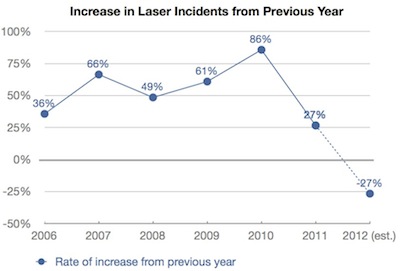
The rate of increase dropped 59% in 2011 (from 86.4% to 27%). If there is another 59% drop in 2012, (dashed line), then there would be a decrease in laser incidents for the first time, from 3,591 incidents in 2011 to 2,836 incidents projected for 2012.
Click to read more...
US: ALPA holds major D.C. conference on the threat of laser illuminations
Speakers generally agreed on the nature and scope of lasers as a threat to air safety. They also offered similar solutions, including educating the public to not misuse lasers, prosecuting those who do, training pilots on how to "recognize and recover" from incidents, increasing the number of reports from pilots and the public, and restricting laser pointer availability.
The ALPA conference made news primarily for the announcement of a new FAA web page, which can be reached via www.faa.gov/go/laserinfo. FAA Administrator Randy Babbitt told the ALPA attendees that the web page -- erroneously described as a "website" in many media accounts -- would centralize the agency's information on laser/aviation safety. The page includes email addresses where pilots, air traffic control and the public can report laser incidents (see separate story about the FAA web page).
Babbitt also said that the FAA currently has filed 18 civil cases against individuals who aimed lasers at aircraft. There is a maximum $11,000 fine in each case.
Other speakers gave updates and information in their areas of expertise.Click to read more...
US: FAA urges pilots, public to report incidents on new webpage
- Reporting Laser Incidents: How to report an incident, for pilots, air traffic control officials, and the general public
- U.S. Laser Incidents by Year: A simple table listing incidents each year since 2005
- Laser Events and Civil Penalties: Press releases about the number of incidents in 2010 and about the June 2011 decision to impose civil fines of up to $11,000. Also, the legal interpretation justifying imposition of the fines.
- Hazards of Laser Illumination: Links to background information for pilots, and two studies of the issue by FAA’s Civil Aerospace Medical Institute
- Planning Light Shows and Other Outdoor Laser Operations: Information and forms for persons planning to use lasers outdoors
Below is the FAA press release announcing the web page:Click to read more...
US: Laser beams usually are not tracking aircraft; most do not enter cockpit windows
The analysis was done by Rockwell Laser Industries (RLI). They examined 6,903 incidents in FAA’s database, dating from 2004 to mid-March 2011.The cockpit was illuminated only in about 1,875 incidents (27%). Of these, the exposure appeared intentional in about 350 incidents (19% of the cockpit illuminations; 5% of all illuminations). “Intentional” was defined as multiple beam exposures or the beam tracking the aircraft.
There were about 100 incidents (1.5% of all incidents) reported eye effects or injuries to the eyes. (A separate analysis by LaserPointerSafety.com shows that the vast majority of eye effect/injury reports are of minor, temporary effects. There are a few claims of eye injuries, and a very few confirmed claims of retinal injury.)
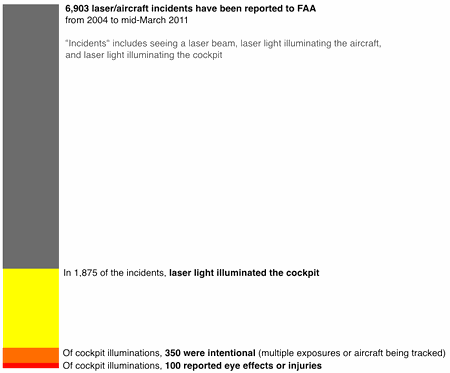
The RLI analysis was done by Kevin Donnelly, and was supervised and presented in August 2011 by RLI president Bill Ertle. Rockwell Laser Industries is a pioneer in providing services and products related to lasers and laser safety.
US: FAA to impose civil penalties of up to $11,000
The Wall Street Journal states that “[t]he change is intended to make it easier to punish violators without resorting to time-consuming criminal proceedings.”
Previously, FAA did not go after laser violators directly. FAA will now routinely bring civil charges, and these will be in addition to any other civil or criminal charges brought by others such as the FBI, or state and local law enforcement.Click to read more...
US: 2012 laser/aircraft incident statistics
What is an FAA-reported “laser incident”?: This is defined as an aircraft pilot seeing one or more laser beams during flight. A mid-2011 study by Rockwell Laser Industries of 6,903 incidents reported to the U.S. Federal Aviation Administration found that in 27% of incidents, beams entered the cockpit (passed through the windscreen). For example, in 2011, there were 3,591 incidents of which approximately 970 (27%) involved beams in the cockpit.
Year-to-Date Comparison
The 3,482 reported U.S. laser/aircraft incidents in 2012 compare with 3,591 incidents during 2011, approximately 2,836 incidents during 2010, and approximately 1,527 incidents during 2009.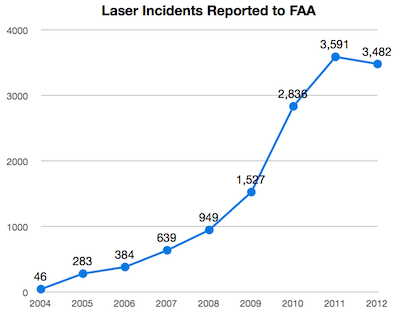
The number of U.S. laser incidents decreased slightly in 2012
Projected 2013 Estimate
If the number of laser/aircraft incidents in 2013 continues to decrease at the same rate as from 2011 to 2012 (-3.04%), then there would be 3,376 incidents in 2013.
Adverse Effects
In 36 (1.0%) of the 3,482 laser/aircraft incidents in 2012, a pilot or aircraft occupant reported a temporary adverse visual effect such as flashblindness, afterimage, blurry vision, eye irritation and/or headache. In four of the 36 eye incidents, the eye effect may have been more serious or long-lasting. In no incidents, either in 2012 or in previous years, was there any permanent eye damage.Total Incidents, 2004 to Date
There have been approximately 13,737 laser/aircraft incidents reported to FAA, from January 1 2004 through December 31 2012..
Click to read more...
US: House and Senate pass legislation against laser pointer aiming
The bill makes it a crime to aim or illuminate an aircraft with a laser pointer. From the bill:
Whoever knowingly aims the beam of a laser pointer at an aircraft in the special aircraft jurisdiction of the United States, or at the flight path of such an aircraft, shall be fined under this title or imprisoned not more than 5 years, or both. As used in this section, the term ‘laser pointer’ means any device designed or used to amplify electromagnetic radiation by stimulated emission that emits a beam designed to be used by the operator as a pointer or highlighter to indicate, mark, or identify a specific position, place, item, or object.
There are three exemptions in H.R. 386: 1) R&D and flight testing approved by FAA, 2) Defense or Homeland Security department operations, and 3) use of a “laser emergency signaling device to send an emergency distress signal.”
From an AP story running in many locations including here.
COMMENTARY: LaserPointerSafety.com has a page with our analysis of H.R. 386, written before the bill was introduced into the current session of Congress.
Australia: 2008 "cluster attack" caused by boys on bicycles
However, it turns out that this incident was caused by boys on bicycles, apparently acting without pre-planning and not knowing how the lasers would affect pilot vision. During a Feb. 2011 briefing to the SAE G10T laser safety group , FAA flight standards liaison Patrick Hempen said that the truth about Sydney has not caught up with the news stories: “The attacks are usually spontaneous in nature, perpetrated by careless or malicious persons.”
Hempen said that investigation by US and Australian officials revealed that the Sydney "cluster attack" was caused by youths, riding their bicycles on a golf course at night, who stopped and took the occasion to illuminate landing aircraft. He noted that the youths’ local community had a history of acrimony directed at the airport authority due to the construction of a new runway which caused more flights over their residential area.
Hempen also investigated several laser events in the Mideast and found many of the so-called "deliberate attacks" to be similar; they were “events perpetrated by youths, in a party-like atmosphere, without care or knowledge of the havoc that they were causing.”
Based on a Feb. 1, 2011 presentation to SAE G10T.
US: 2,836 laser events reported in 2010; FAA expresses concern
FAA spokesperson Laura Brown told LaserPointerSafety.com that in roughly 90% of the reports, the cockpit and/or pilot was illuminated by the laser. (In the other 10%, a beam was seen outside the aircraft but light did not enter the cockpit.) As far as injury reports, Brown said that these were “fairly rare”.
The FAA’s press release listed the top 20 affected airports, with Los Angeles International Airport topping the chart with 102 “laser events” in 2010. LaserPointerSafety.com has further analyzed the airport data to show that for these top 20 airports, an event occurred once every 7,000 takeoffs and and landings; the analysis is here.
According to the press release, “[t]he increase in reports is likely due to a number of factors, including the availability of inexpensive laser devices on the Internet; higher power levels that enable lasers to hit aircraft at higher altitudes; increased pilot reporting of laser strikes; and the introduction of green lasers, which are more easily seen than red lasers.”
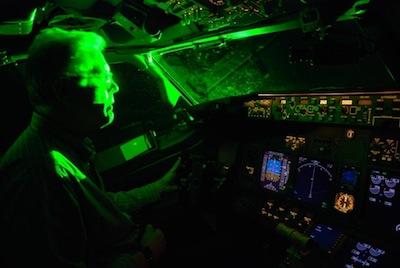
The FAA released the photo above, illustrating what a direct laser illumination of a cockpit can look like.
To read the full FAA press release, and see the list of 20 most affected airports, click the “Read More...” text below. In addition, updated statistics for the current year are here.
US: FAA issues study of 2,492 laser events from 2004 to 2008
The study is entitled “The Illumination of Aircraft at Altitude by Laser Beams: A 5-Year Study Period (2004-2008)”. The FAA’s abstract is here; and the full 12-page report in PDF format is here.
